11 Incredible Weekend Trips from Portland to Plan ASAP
As you’ll find plastered all over this website, one of the things we love about living in Portland is the fact that, within 90 minutes, you can either be on the beach at the Pacific Ocean, or at the base of the highest peak in Oregon.
What we don’t often say is that when you expand that to 3-4 hours away from Portland, it becomes an even more incredible array of destinations ranging from alpine to coastal to desert, and just about everything in between.
In this guide, we’re going to go through our absolute favorite weekend trips from Portland along with everything you need to know to plan your trip (like what to do, see, eat, and drink – the important stuff!).
We’ll start with closer destinations and work our way outwards, expanding the view to places in Washington State that are doable in a weekend.
For each place, we’ll give you our take on what makes that destination special, take you through our favorite things to do and see, and give you a starting point in terms of where to stay.
Our intention here is that, by the end of this guide, you’ll have discovered a new weekend getaway to start planning, and you’ll have a solid starting point for planning your trip.
As we experience more places in the Pacific Northwest, we’ll be expanding this guide to include other places that we love.
Sound good? Let’s get into it.
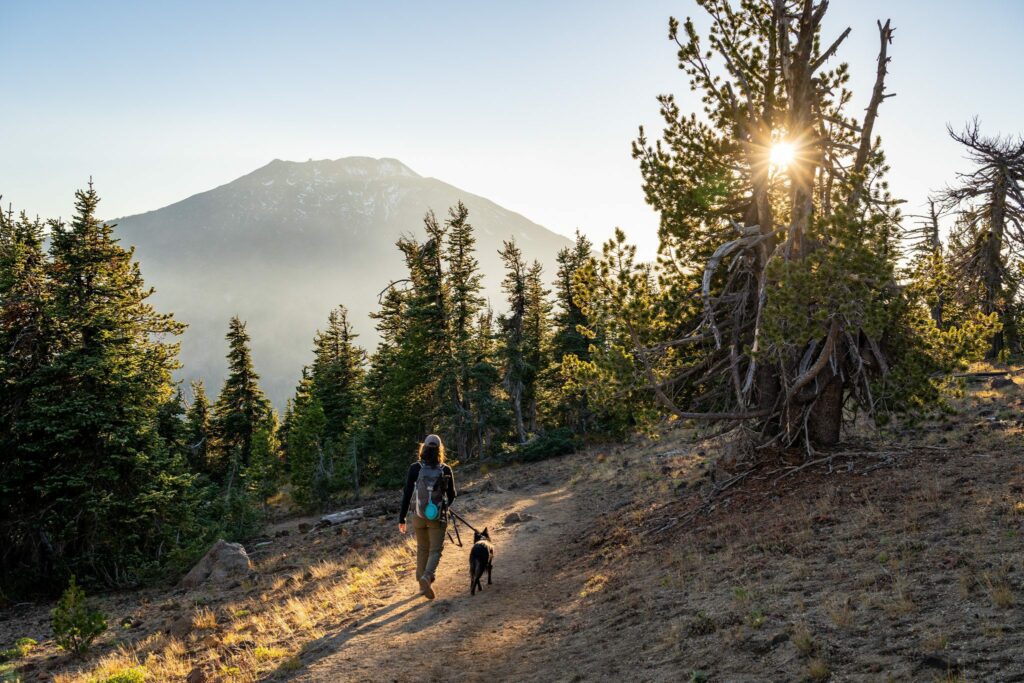
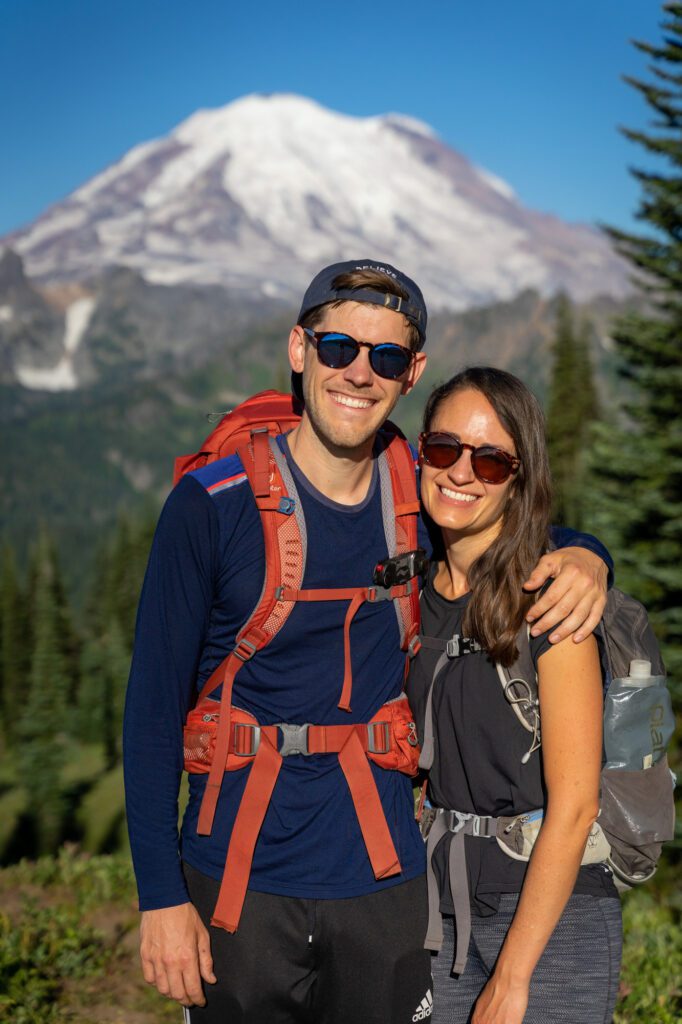
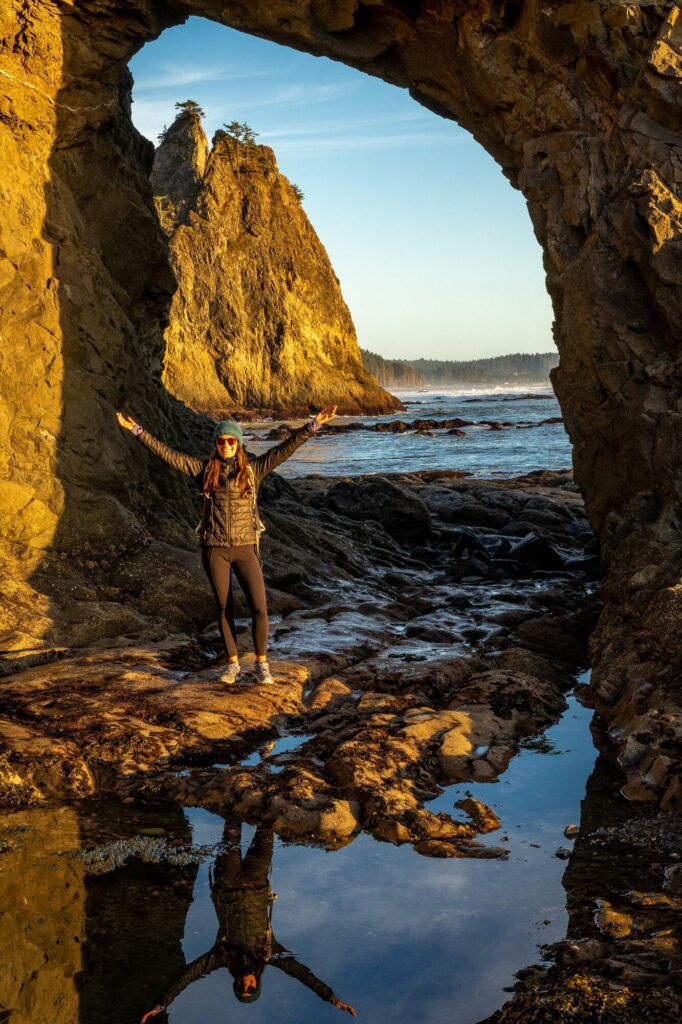
Disclaimer: Some of the links in this post, like hotel links, are affiliate links, meaning at no additional cost to you, we make a little bit of money if you click through and book. That being said, we would never recommend something to you that we don’t stand behind 100%.
Our Favorite Weekend Getaways from Portland: A Complete Guide
Let’s get straight into the amazing weekend trips we’ve chosen for this guide.
Is this an exhaustive list of every possible place you could go? Absolutely not. Instead, we’ve narrowed it down to 10 places that we love, and think you will too.
Rather than giving more destinations, we’ve made the decision to go deeper on the ones we’re including.
As we explore more of the amazing places to visit in Oregon, we’ll revise this list and add those places (the Painted Hills are next up on our list).
Generally speaking, you’re going to need a car to make the most of a weekend trip to the vast majority of the places on this list. There just isn’t a great train or public transit option for most of them.
If you don’t have a car, your options are limited.
Our top recommendation would be to rent a car for the weekend, but that’s going to add to the cost and sometimes, driving sucks.
If you don’t have a car, and don’t want to rent one, there are a few getaways that are accessible by other forms of transportation.
They are:
- Seattle (via Amtrak)
- Mount Hood (via bus)
- Hood River (via bus)
However, it’s important to note for Hood River and Mount Hood that a car is going to allow you to do and see far more than going carless.
Less so for Seattle, which has a robust public transit network to get around the city without a car.
Mount Hood
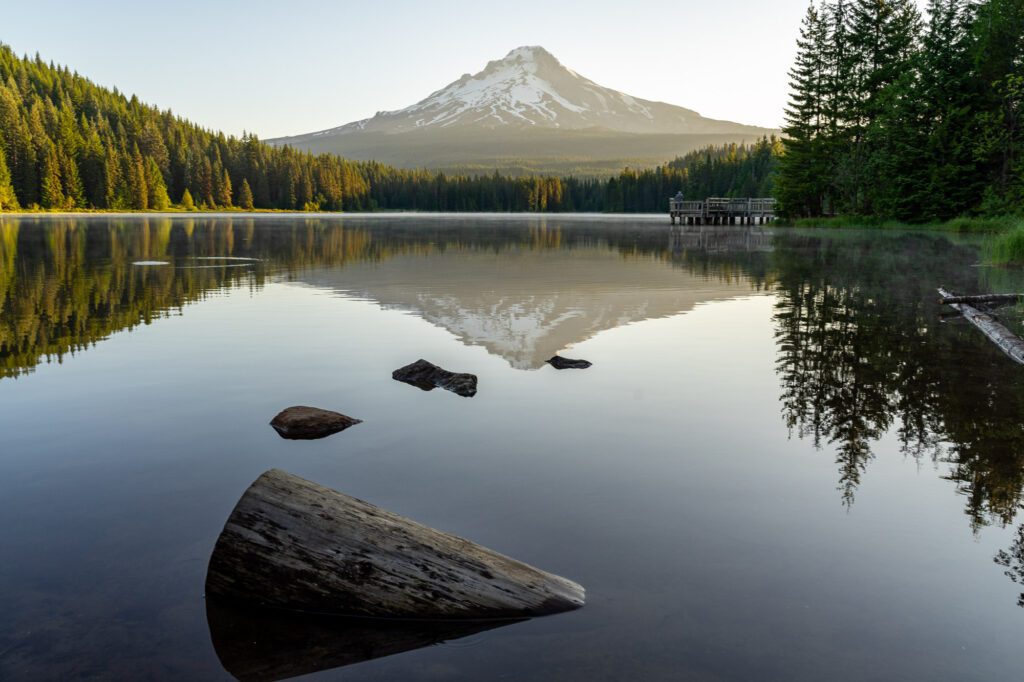
Matt grew up in Seattle, and has a deep appreciation for Mount Rainier because of its role as the barometer of a nice day in Seattle.
Oh, you can see Mount Rainier from the city? It’s a good day!
In many ways, Mount Hood plays the same role for Portland.
It’s the reminder that, even if you’re doing something mundane at that particular moment, adventure is out there waiting for you (and it’s just 90 minutes from your front door!).
If you didn’t already notice based on those first few sentences, Mount Hood is our favorite of the outdoor playgrounds near Portland in every season, and we find ourselves up there at least once in every season.
In the summer, it’s a dazzling display of wildflowers, alpine lakes, and unobstructed views of Mount Hood’s snowy peak.
In the winter and early spring, it’s a wonderland of snowy meadows begging for you to strap on a pair of snowshoes and approachable ski resorts.
What to Do at Mount Hood
We’re going to focus on visiting in the summer, which is our favorite time to visit Hood for more than a day trip to go skiing (Mount Hood Meadows is our favorite ski resort up there, for what it’s worth).
In the summer, it’s all wildflower meadows, crystal clear lakes, and views of Mount Hood around every bend in the hiking trail.
Here are some of our favorite things to do up at Mount Hood, most of which are hikes.
P.S. For more hikes, head over to read our more in-depth guide to hiking at Mount Hood.
McNeil Point
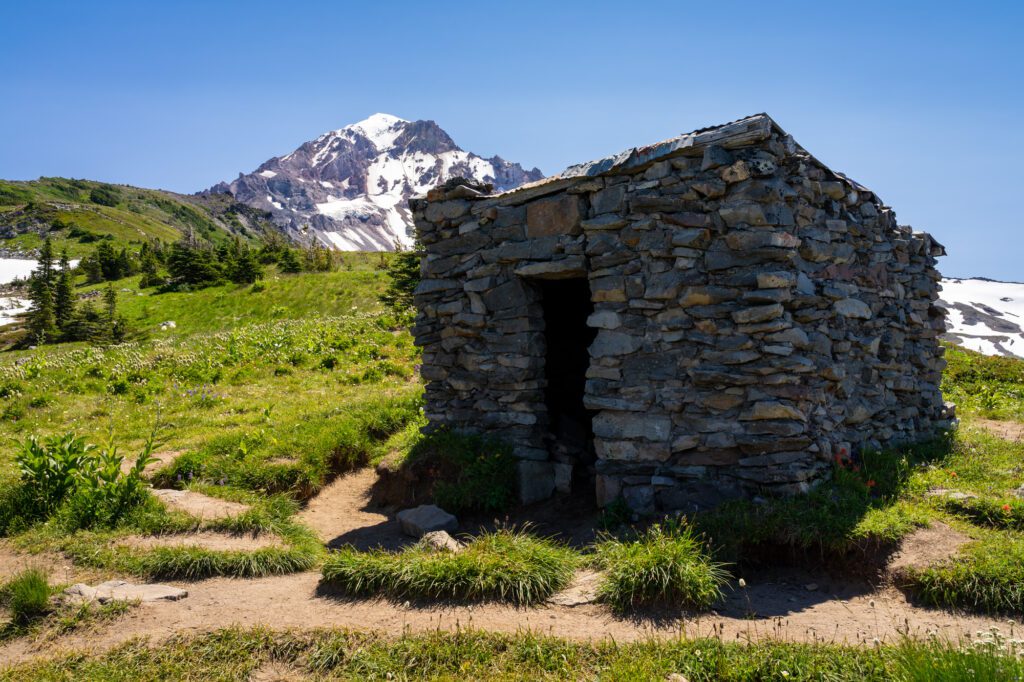
McNeil Point is both the best hike at Mount Hood (in our opinion, anyway) and also the hardest outside of the Timberline Trail.
This hike starts with one of the best views in the state from Bald Mountain, and continues up to a ridge where you’re so close to the face of Mount Hood that you can almost reach out and touch it.
It’s hard, so don’t underestimate the climbing. But we think the payoff is well worth it.
We have an entire guide dedicated to the McNeil Point Trail – including logistics like which route to take, and a complete trail guide – which you should read for more detail.
Tamanawas Falls
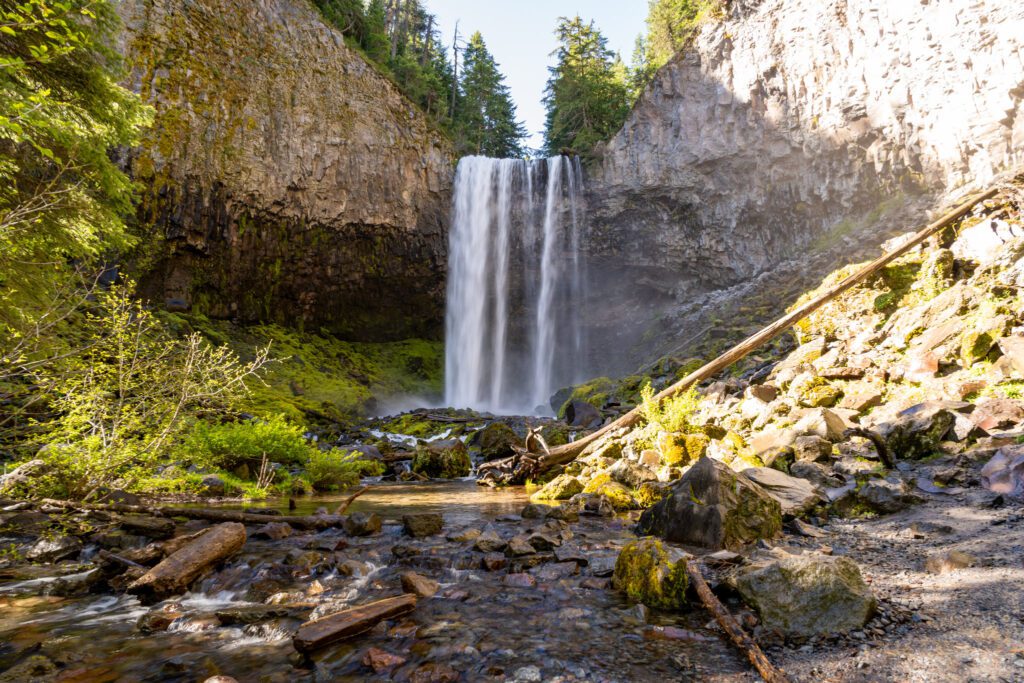
A much more relaxing hike than the first one, Tamanawas Falls quickly became one of our favorites after we hiked it for the first time last summer.
It’s relatively easy, and the payoff at the end is one of the best waterfalls in Oregon, we think.
Two things to know are that it’s on the eastern side of Hood, so it’s a 30 minute drive from Government Camp, and the parking situation can be a nightmare, so get there early.
We have an entire guide dedicated to giving you all the information you need to hike the Tamanawas Falls trail, which you should read for far more information than we’ve fit into this summary.
Ramona Falls
Another great waterfall hike! The hike to Ramona Falls is a relatively straightforward hike through the woods at the base of Mount Hood, except for the unmaintained river crossing, which can be a pain in the summer (and we wouldn’t take our dog, for what it’s worth).
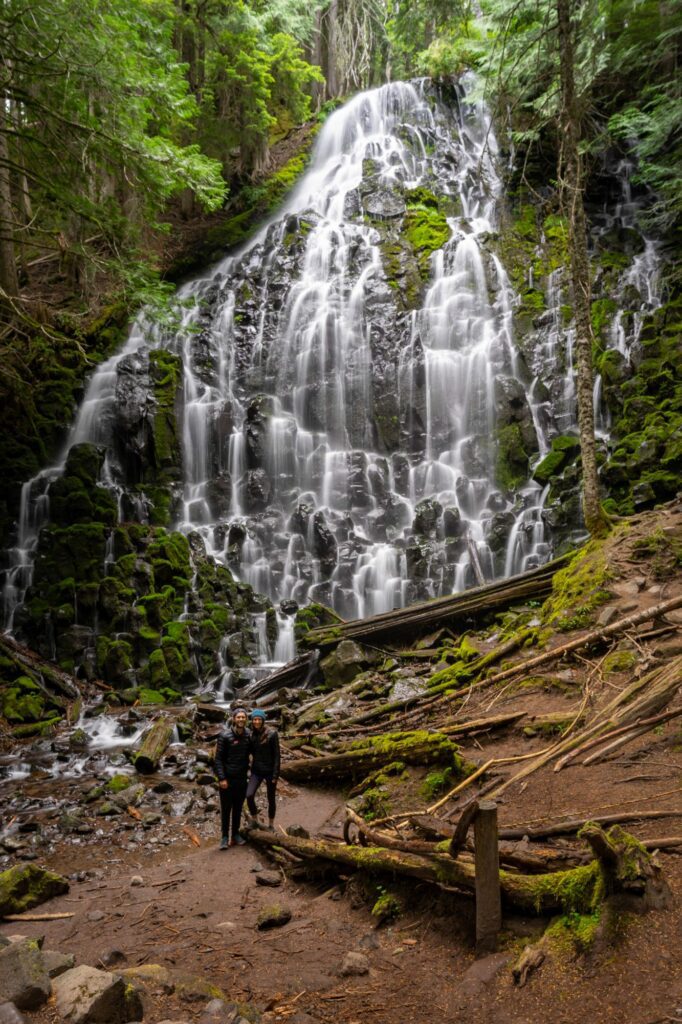
If you make it across the river, the reward is a 100 foot tall waterfall that feels as wide as it is tall as it cascades down the rock face above you.
It’s a different style of waterfall than most in the Gorge or around Hood, which is fun.
Umbrella and Sahale Falls Loop
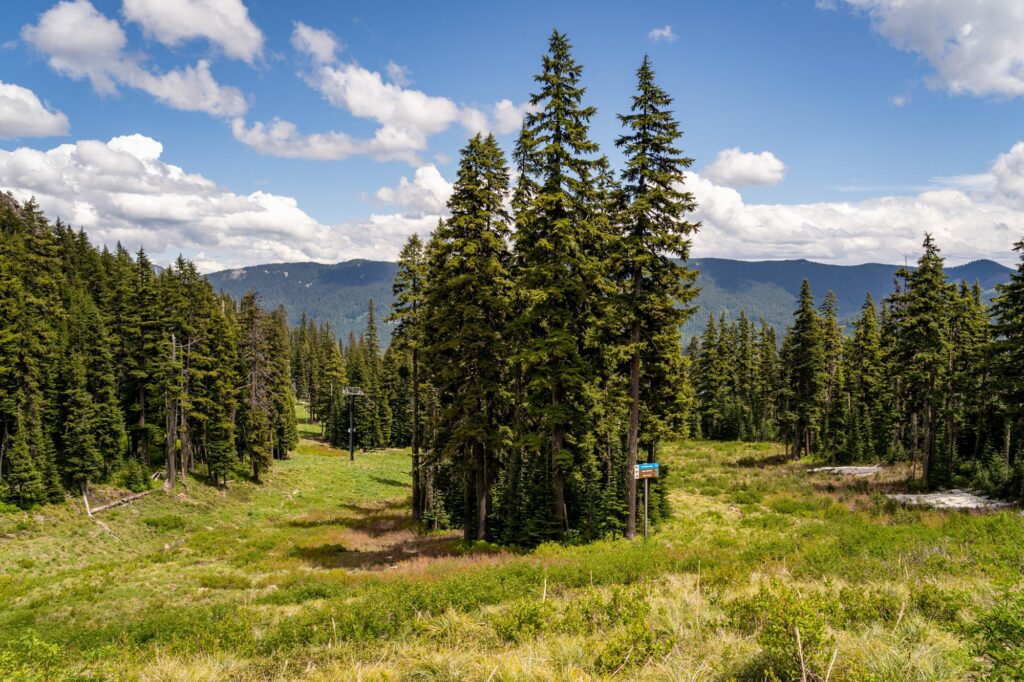
Another hike that we discovered last summer that is less crowded and equally beautiful.
This hike starts from the parking lot at Mt. Hood Meadows, and goes on a little journey past two waterfalls (though you can barely see the second, Sahale, from the trail – drive here after the hike for a better views) and across the ski slopes that are blooming with wildflowers in the summer.
More information here.
Bend
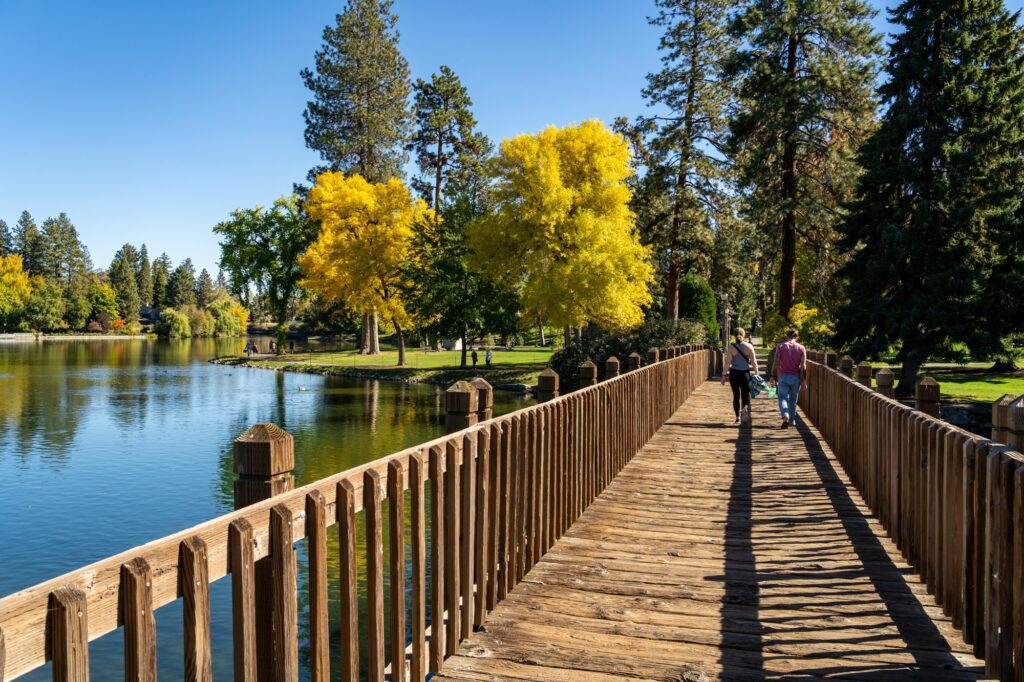
Bend absolutely belongs on this list because it offers something a little different than most of the cities on this list so far, but not TOO different.
It shares some of the attributes we love about Portland, like a thriving small business-focused scene and world-class wilderness within an hour or so of the city.
The different piece comes from the landscape.
Bend sits in the eastern foothills of the Cascades right on the divide between the wetter, greener landscapes of western Oregon, and the high desert of central and eastern Oregon.
Smith Rock is a great example of the types of landscapes that call the high desert home, with giant rock formations that feel like they belong somewhere in Utah, not within a few hours of Portland.
Overall, we really like Bend, though it has become more expensive and developed over the past several years, losing a part of the small town charm that attracted Portlanders (a portion of whom have moved to Bend at some point recently).
A weekend trip to Bend, at least for us, should include some kind of hike or bike ride in the morning, beers in the afternoon and evening, and plenty of time soaking up that central Oregon sun in between.
After spending a week in Bend this past fall, we’ve completely re-written this section to reflect our more recent experiences, when we’ve discovered even more of the area near Bend.
It’s worth noting that we’ve only ever been to Bend between May and October, so all of our recommendations are centered around outdoor activities that are accessible during that time frame.
Bend would also make an excellent ski vacation – Matt grew up in Seattle and skied at Mount Bachelor years and years ago now – but we haven’t done it recently and don’t have strong thoughts or opinions on it until we do it ourselves!
What to Do in Bend
Here are some of our favorite things to do, see, eat, and drink in Bend (note that Matt has Celiac Disease, so we don’t do a whole lot of brewery hopping).
Hike to the Top of Pilot Butte
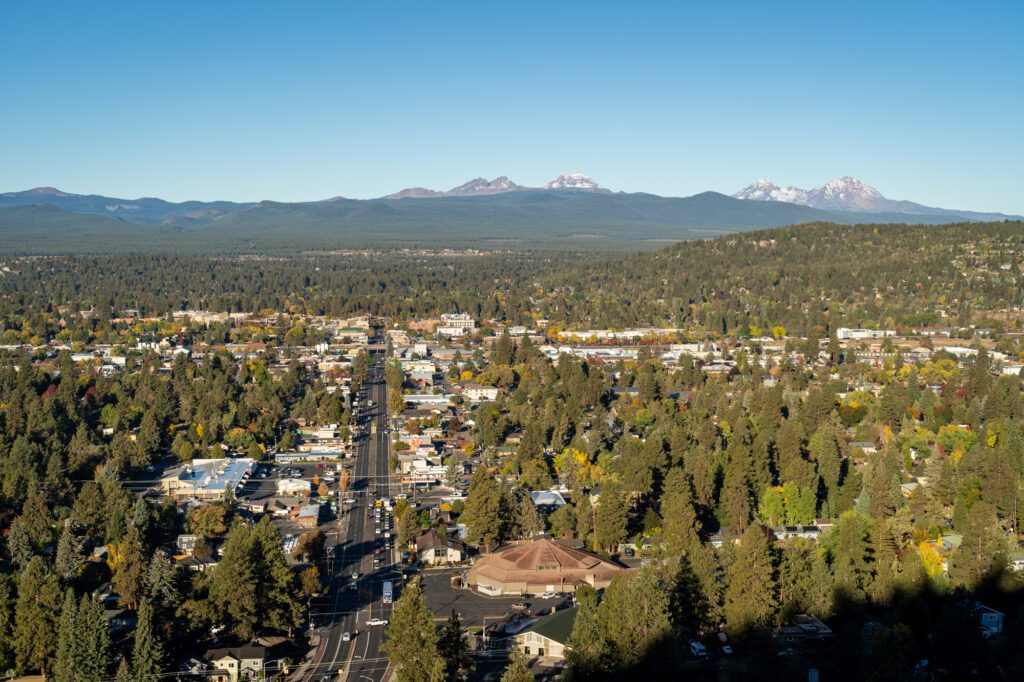
Pilot Butte is a cinder cone – a concept that you should be familiar with if you live in Portland – right in the middle of Bend.
A short hike that circles up the butte brings you to a showstopping view of the surrounding landscape, including great views of the Cascades to the west and a nice compass that tells you what peaks you’re looking at, and how tall they are.
It’s exposed, so get an early start and wear sunscreen.
It’s a quick, easy hike, and we do it every time we’re in Bend.
Explore Cascade Lakes National Scenic Byway
The Cascade Lakes National Scenic Byway heads west out of Bend into Deschutes National Forest, and just about every time we drive this stretch we consider never coming back out of the mountains.
There are several excellent hikes out here, including Tumalo Mountain, Green Lakes, and Moraine Lake / the South Sister (all of which make our list of the best hikes near Bend).
Plus, Mount Bachelor and Sparks Lake (one of our favorite photo spots in Oregon – and the header image on our home page).
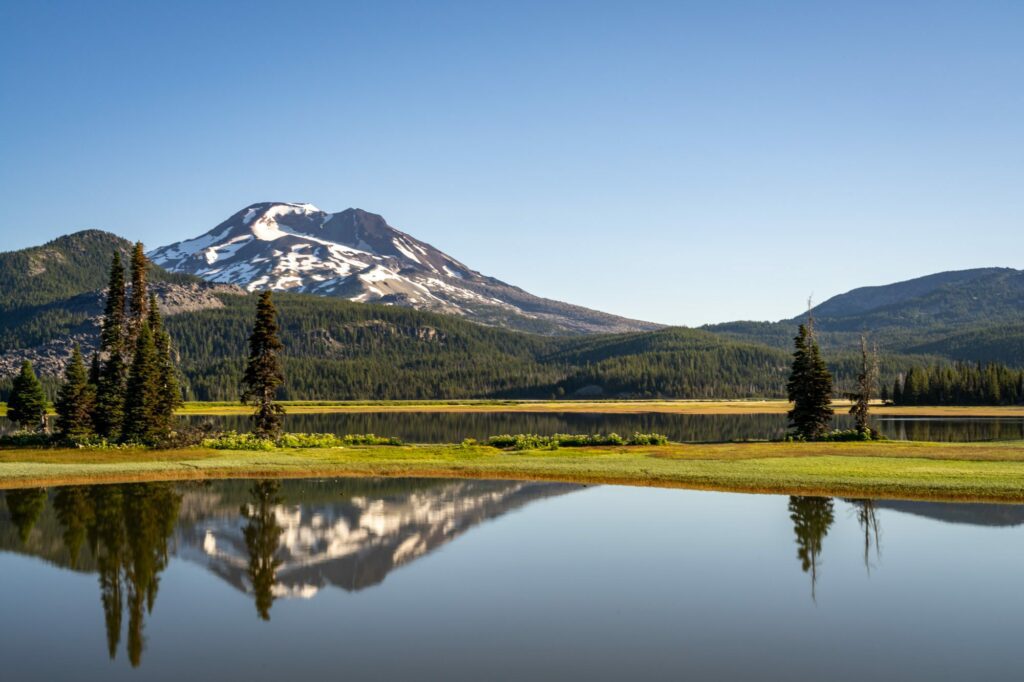
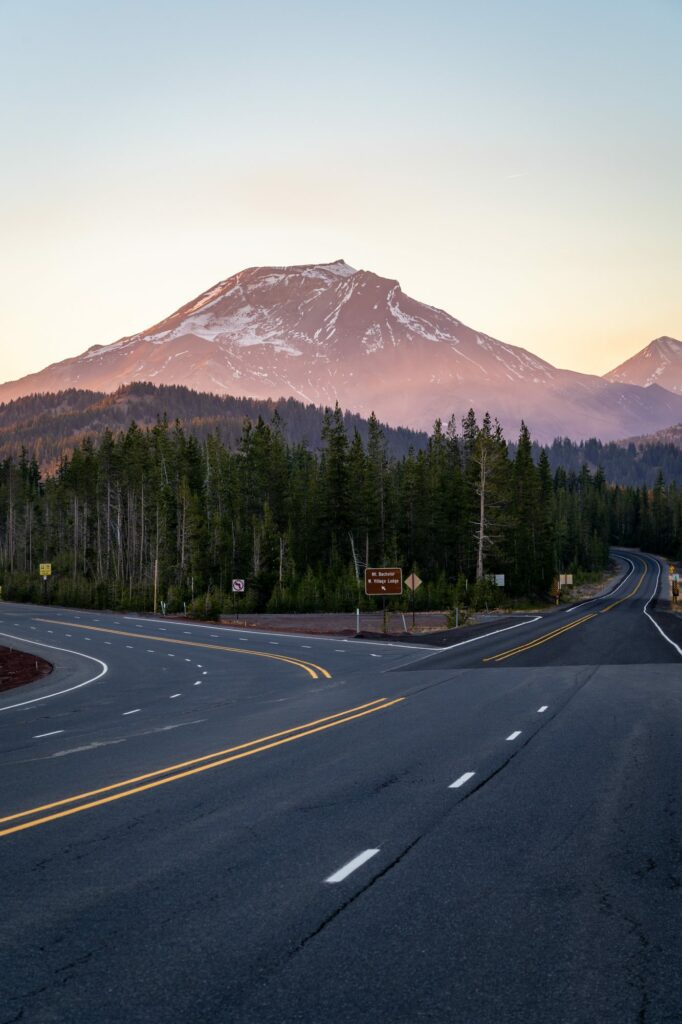
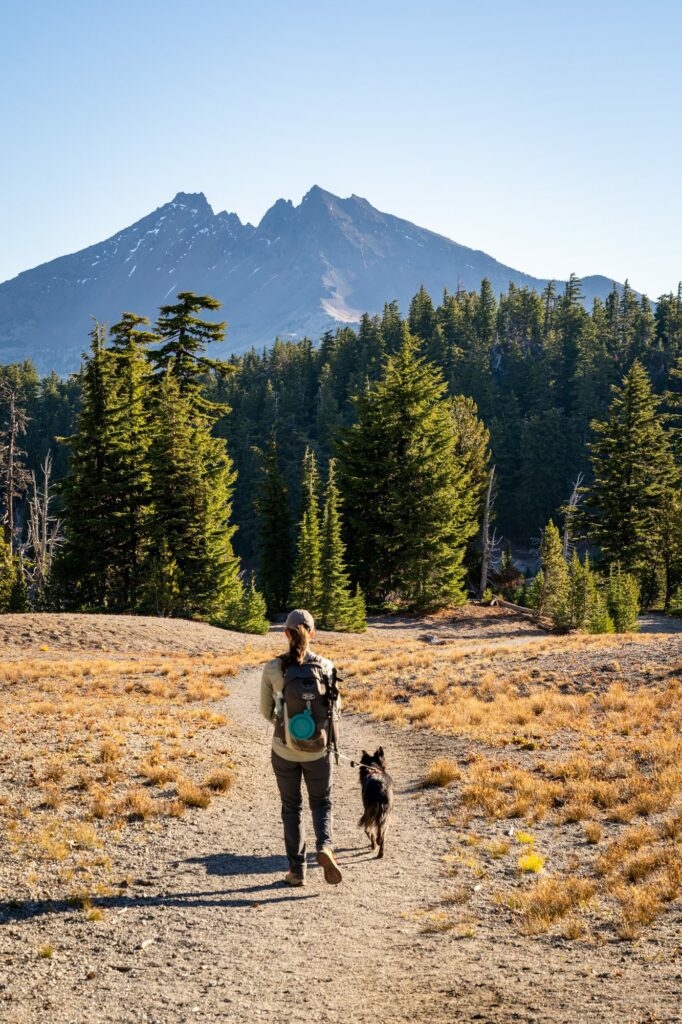
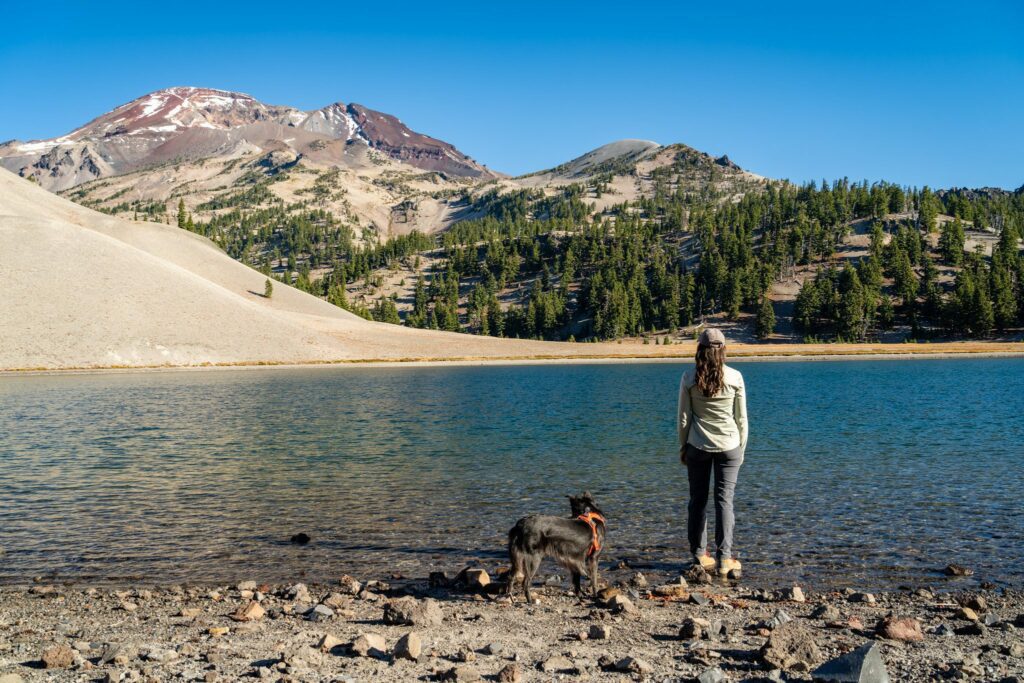
Visit the Deschutes Historical Museum
It will take you about an hour AT MOST, but I really enjoyed the Deschutes Historical Museum. It’s a hop, skip, and a jump away from Downtown Bend.
Their whole mission is to preserve Bend’s history by cataloging documents and putting it together in a way that allows current residents and visitors to learn about the rich and interesting history in Central Oregon.
I enjoyed it, and would recommend it for a quick and concise splash of historical context during your trip to Bend.
Explore Newberry Volcanic National Monument
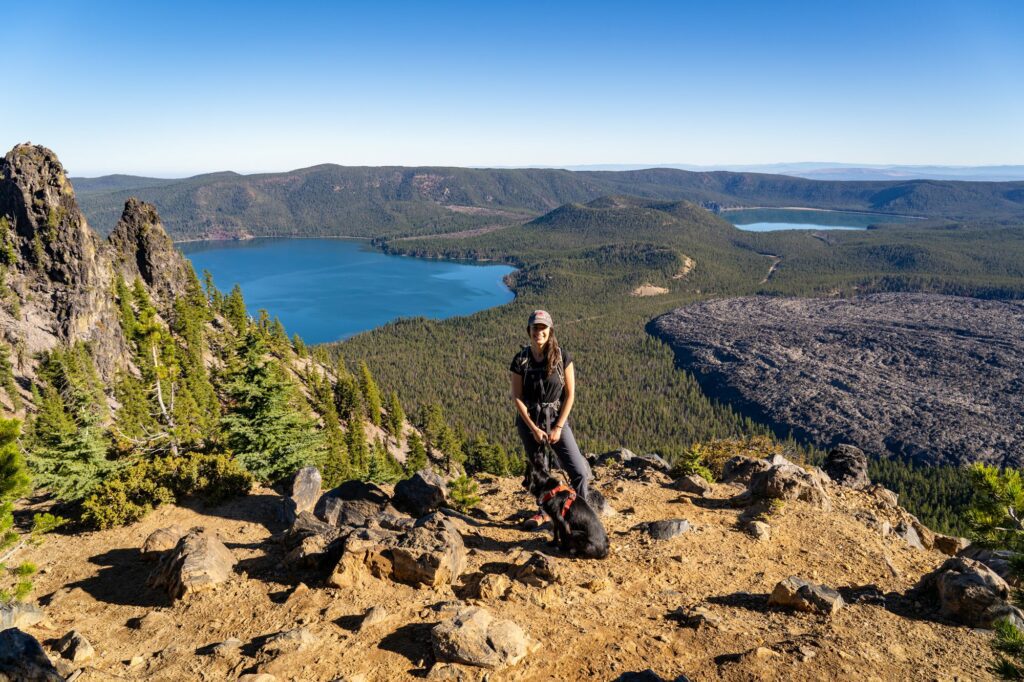
This was a discovery on our latest trip, and we had no idea it existed until we were planning that weeklong trip and were on the hunt for new things to do and see.
Turns out, there’s a volcano about 45 minutes south of Bend with a landscape that looks strikingly similar to the one near Crater Lake (which is less than an hour south).
It’s worth hiking (or driving) to the top of Paulina Peak (here are the hike details) for panoramic views of the lake and lava flow, walking out to Paulina Falls, and walking along the lakeshore.
Plus, on your way there or back, stop by the Trail of the Molten Land to meander through a volcanic landscape to the top of a cinder cone.
Day Trip to Smith Rock State Park
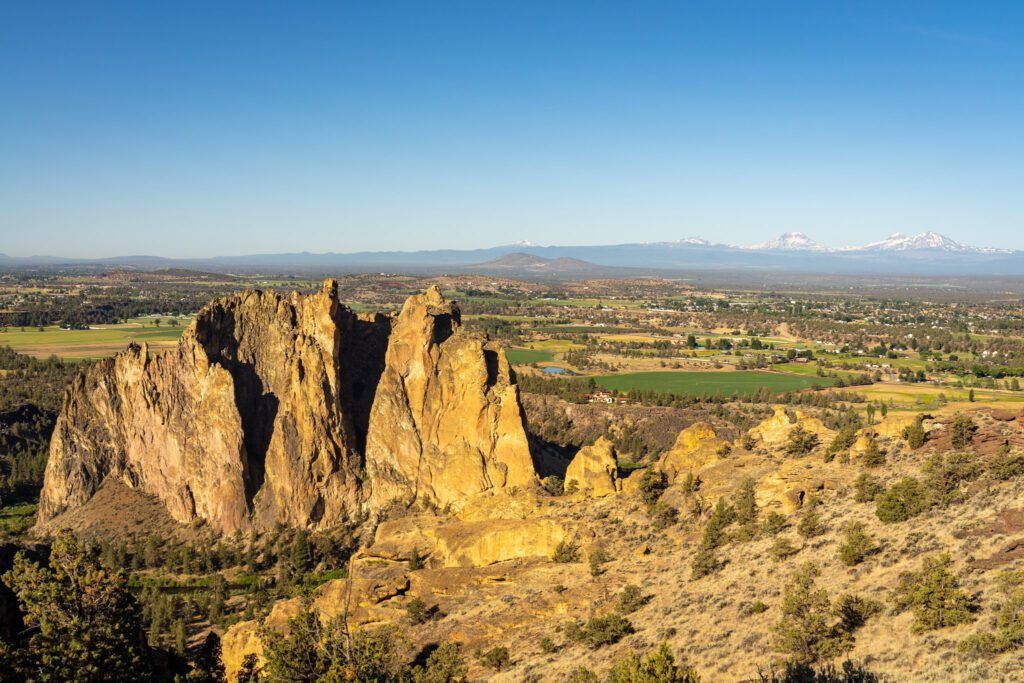
Smith Rock is classic Central Oregon for us. It looks like it belongs somewhere in Utah or the Southwest, with towering orange rock formations rising above a drier, flatter landscape.
But from the top of Misery Ridge, it has excellent views of the snowy peaks of the Cascades that are a Pacific Northwest Classic.
The main highlight for us here is the Misery Ridge Trail, which is an aptly named tough hike that climbs straight up a gully to reach the top of Misery Ridge.
From there, you have great views of Monkey Face – one of the premier climbing destinations in Oregon – along with the aforementioned mountain views.
To get back, you can either follow the shorter, easier River Trail, or embark on a longer journey on the Summit Trail, which has great views of the park but is longer and more exposed.
Eating and Drinking in Bend
This section has to start with an important caveat. Matt has Celiac Disease, which means he can’t really partake in most of the food and beer that makes Bend a great place for a weekend trip.
However, we have been to Bend with friends and have been to a bunch of breweries over those trips.
In terms of beer, we really like Crux Fermentation Project and their outdoor space (soak up that central Oregon sun!). Other good options are 10 Barrel and Bend Brewing (right on the river!), along with trivia at Silver Moon on Thursday nights (which was Oregon-themed last time we were there).
For cider, head up to Tumalo and experience the 1-2 punch of Bend Cider and Tumalo Cider, which are around the corner from each other.
For food, we like Spork (fusion) and El Sancho (tacos!).
For coffee, go to Lone Pine Roasters in Downtown Bend, or Still Vibrato west of the river.
Hood River
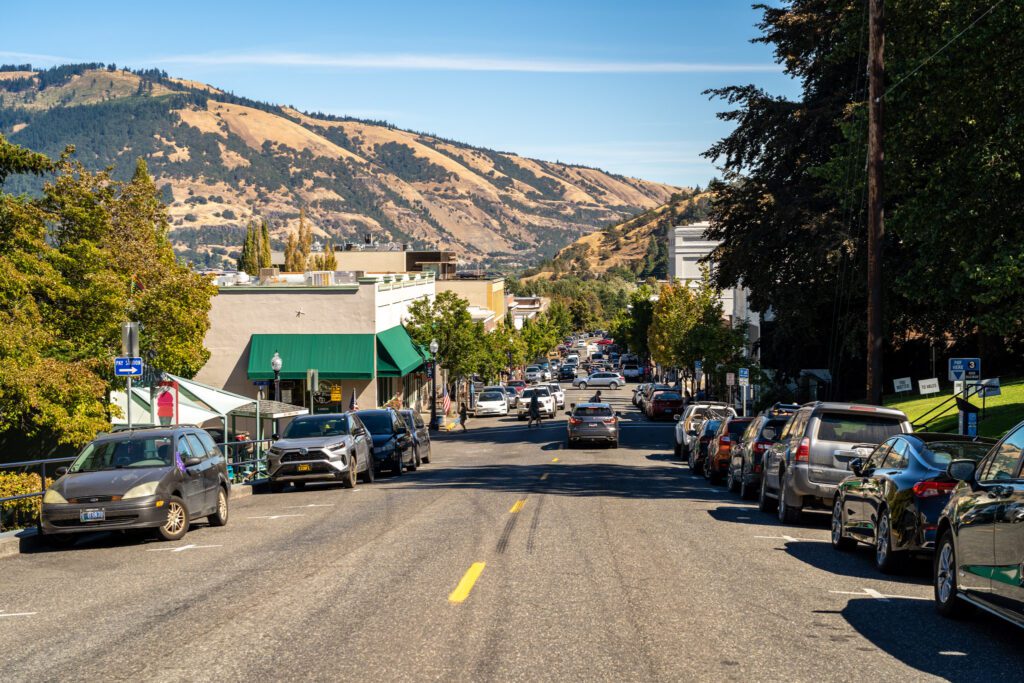
Hood River is Portland’s other adventure destination (assuming the first is Mount Hood).
Much like Bend, Hood River sits at the border between the wetter, cooler Cascades and the warmer, drier high desert of eastern Oregon.
It’s world-renowned for its water sports – particularly windsurfing thanks to the wind whipping through the Columbia River Gorge – and is a lovely little town with plenty of breweries and wineries.
In addition to being a nice place to spend a weekend, Hood River’s central location means you’ve got great access to the waterfalls and other hikes in the Columbia River Gorge, the eastern flank of Mount Hood (where you’ll find great hikes in the summer, and great skiing in the winter at Mount Hood Meadows), and more.
Hood River makes for both an excellent day trip from Portland, but we’ve also done a couple of weekend stays out there over the past couple of years and it allows for a little more time to enjoy the warmer, drier weather, outdoor activities, and the Hood River Valley.
What to Do in Hood River
Here are some of our favorite things to do in Hood River, in no particular order.
Drive the Fruit Loop
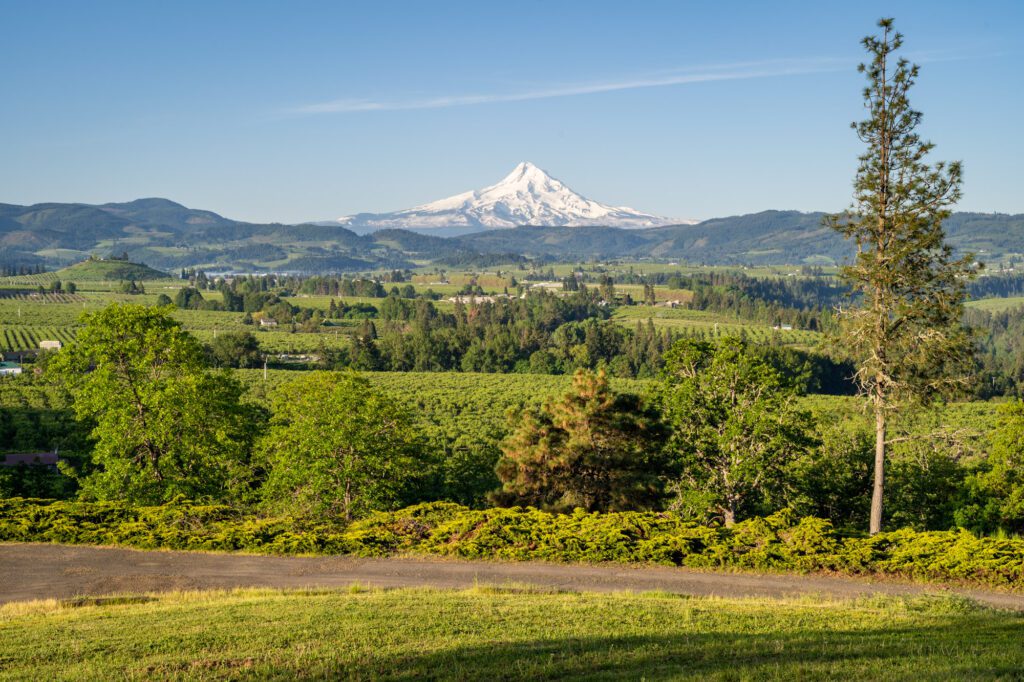
The Hood River Valley, which sits directly south of Hood River at the base of Mount Hood, is one of the most fertile areas in all of Oregon.
You’re sure to notice all the apples, pears, cherries, and stone fruits growing if you’re visiting in the summer.
Combined with the excellent views of Mount Hood and Mount Adams from various points in the valley, this is a great way to spend half a day or so.
Head south out of town to Panorama Point (here on Google Maps), a great sunrise / sunset spot with a nice view of Mount Hood across the valley.
Then continue south to Draper Girls, a farm with u-pick fruit in the summer (cherries are sometime in August, depending on the year).
On your way back, hit the Gorge White House, which is a fun place to get out, walk through the fruit trees, and enjoy a warm day on their patio.
Wine Tasting near Hood River
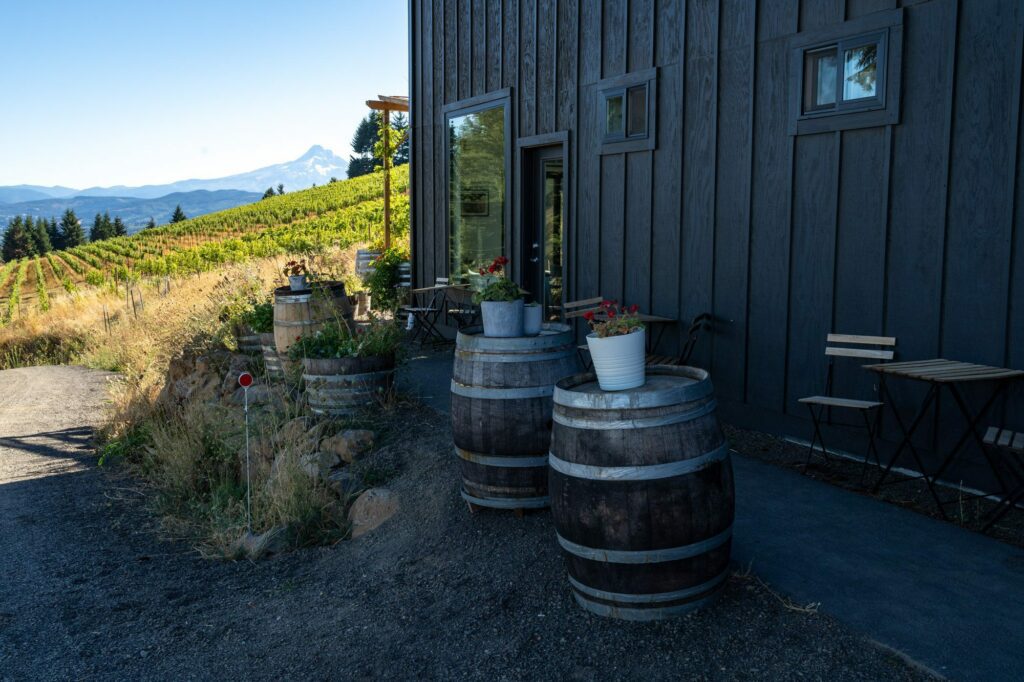
While it’s not as prestigious as the Willamette Valley, the area around Hood River is a productive wine region.
Despite their proximity to one another, the wines out here are different thanks to the different climate and higher elevations (particularly on the Washington side of the Gorge).
We love driving over to the Washington side, where you’ll find Loop de Loop Wines (our favorite tasting experience in the Gorge) and Le Doubblé Troubblé, which is right in the town of White Salmon.
There are quite a few other wineries on either side of the river, including a couple of spots in the town of Hood River itself.
While it’s not a winery, we really enjoy Hood River Common House, a bar with a great wine, beer, and cider selection right in the middle of all the action in Hood River.
Hiking near Hood River
There are a bunch of great hikes near Hood River, and basing yourself this far east in the Gorge means you’ll be closer to some of the hiking trails that are slightly further from Portland.
We’re partial to Coyote Wall, which has amazing displays of wildflowers in the spring and early summer.
Tamanawas Falls is another great hike up towards Mount Hood that we really enjoy.
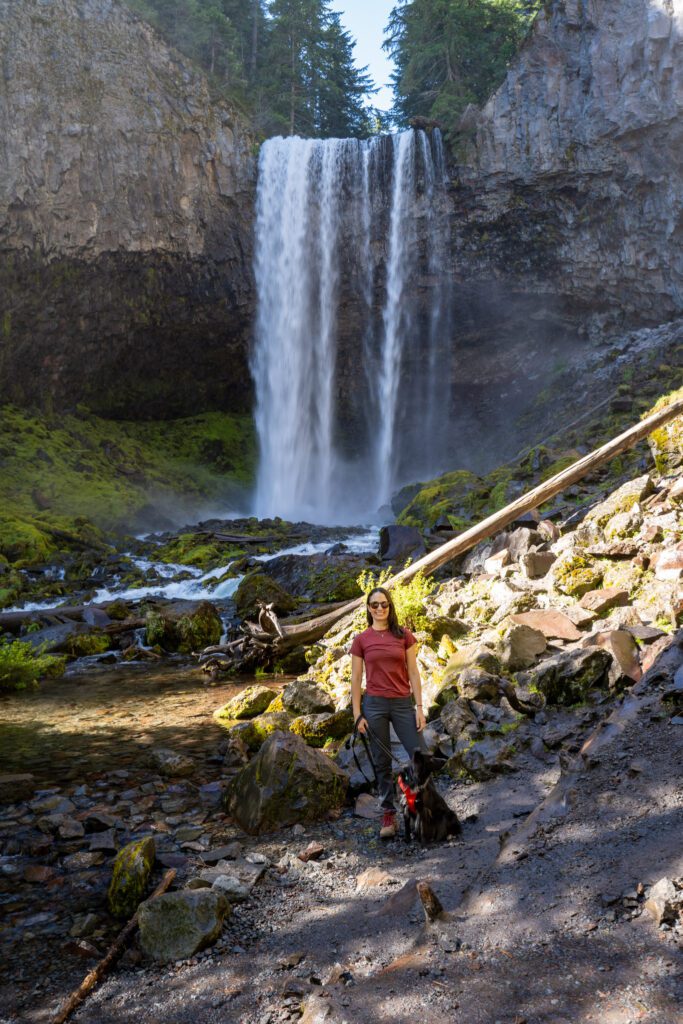
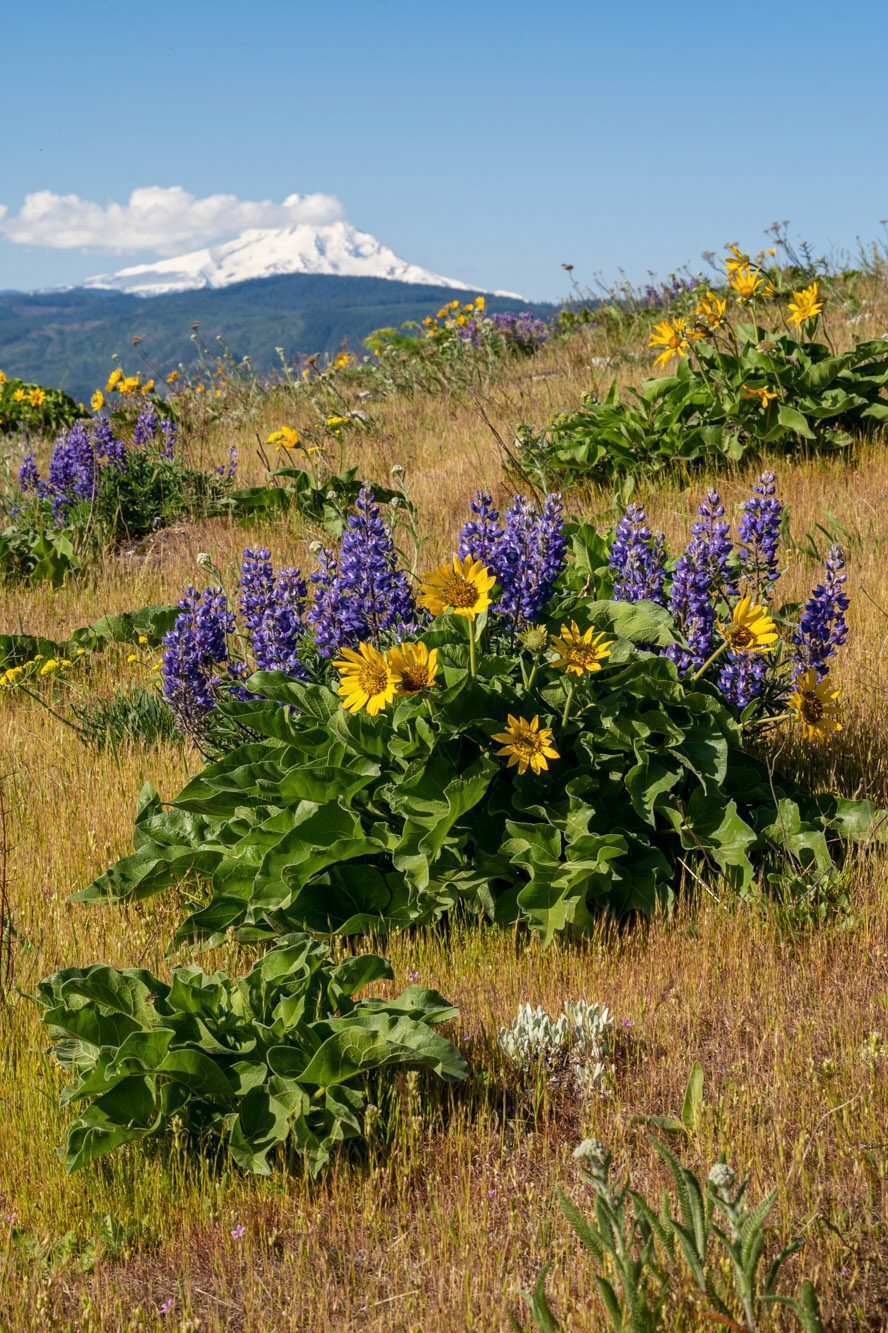
The last hike we’d recommend, which is a little further out but is worth the drive, is the Sleeping Beauty Trail.
From the top of a steep ascent, you’ll be atop a rocky outcropping with an unobstructed view of Mount Adams and more distant views of other nearby peaks.
Rowena Crest & Tom McCall Preserve
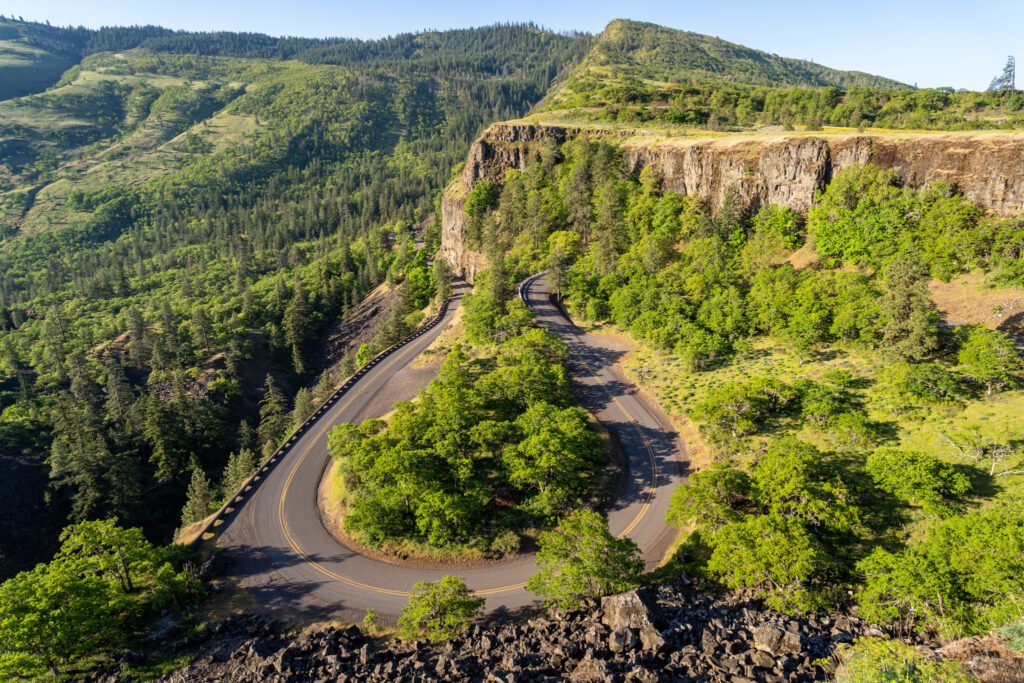
Drive 20 minutes east along the Oregon side of the Columbia River Gorge, most of it along the Historic Columbia River Highway, and you’ll find yourself in a very different landscape than the one closer to Portland.
This section of the Gorge gets warmer, drier, and features far fewer waterfalls and far more rattlesnakes.
The best stops to make along the way are Memaloose Hills, especially in May and June for the incredible display of wildflowers, Rowena Crest, where you’ll have a great view of a picture-perfect bend in the road, and Tom McCall Preserve, where the hike to McCall Point takes you onto the plateau perched above the Gorge.
The Three Capes (Tillamook, Cape Kiwanda, and Cape Lookout)
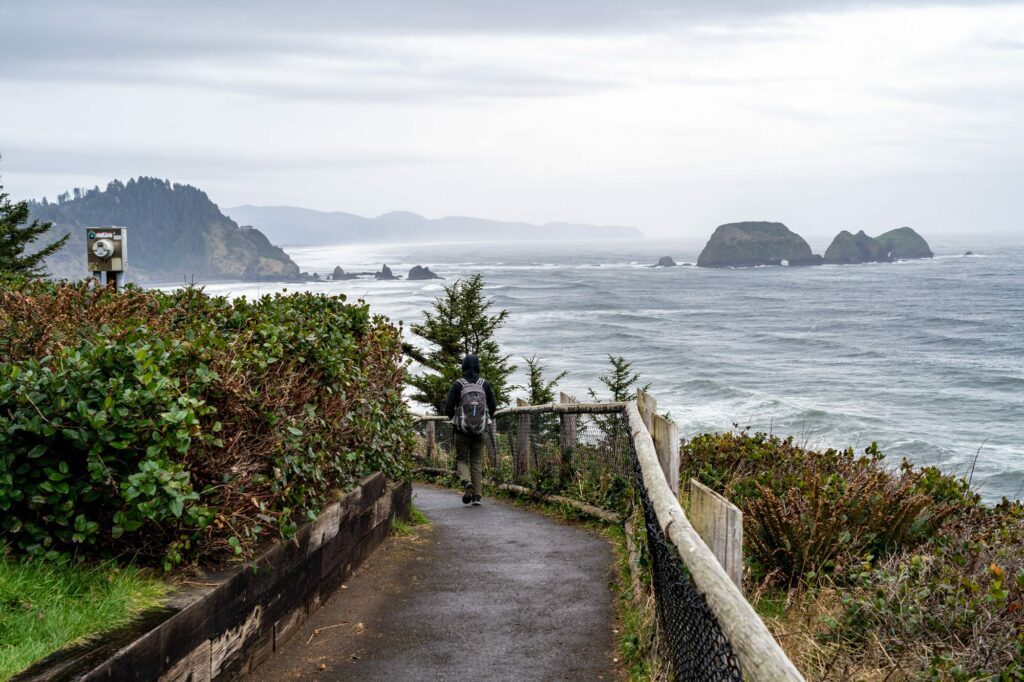
The Three Capes Scenic Route is a coastal drive that takes you from Cape Meares, where you’ll find a cute little lighthouse (and we do mean little), down through Cape Lookout, which juts out into the ocean with great views up and down the coast, and down to Cape Kiwanda, a wide, sandy beach packed with surfers.
This is one of our favorite stretches of the Oregon Coast, with some great hikes, wide sandy beaches, and, of course, the very scenic capes that the route is named after.
There are plenty of things to do and see on this 24 mile stretch of coast to fill a weekend trip, though most people do it as part of a broader Oregon Coast road trip.
For the purposes of this guide, we’re talking about the combination of Tillamook and the Three Capes Scenic Route, which is a lovely drive from Cape Meares down past Cape Lookout, ending at Cape Kiwanda.
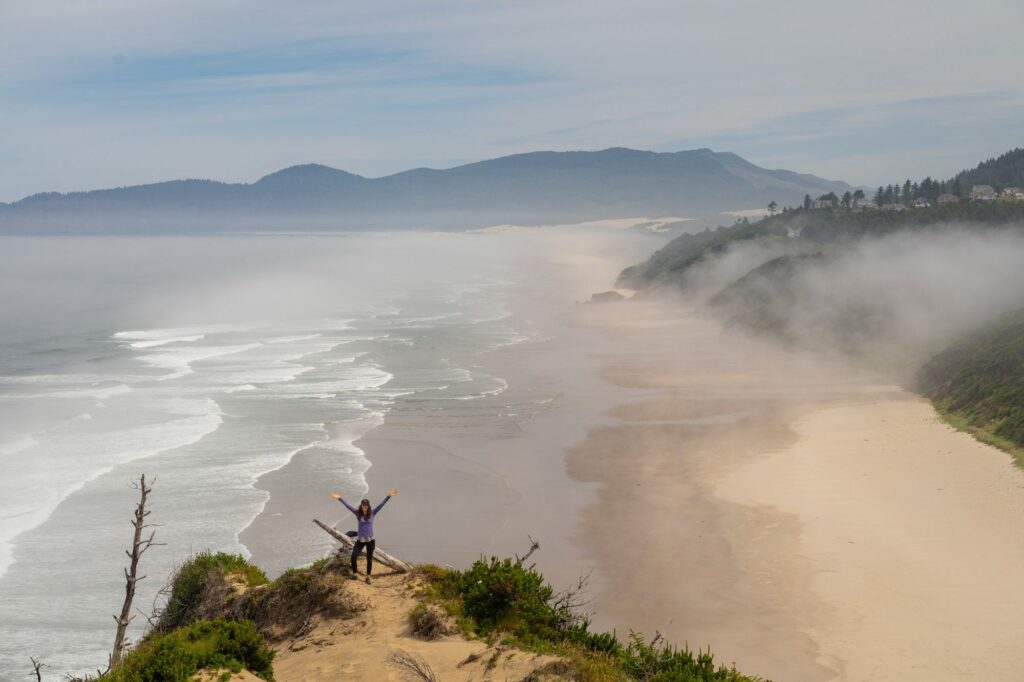
What to Do Near the Three Capes Scenic Route
Here are our favorite things to do, see, eat, and drink near Tillamook and along the Three Capes Scenic Route.
Tillamook Creamery
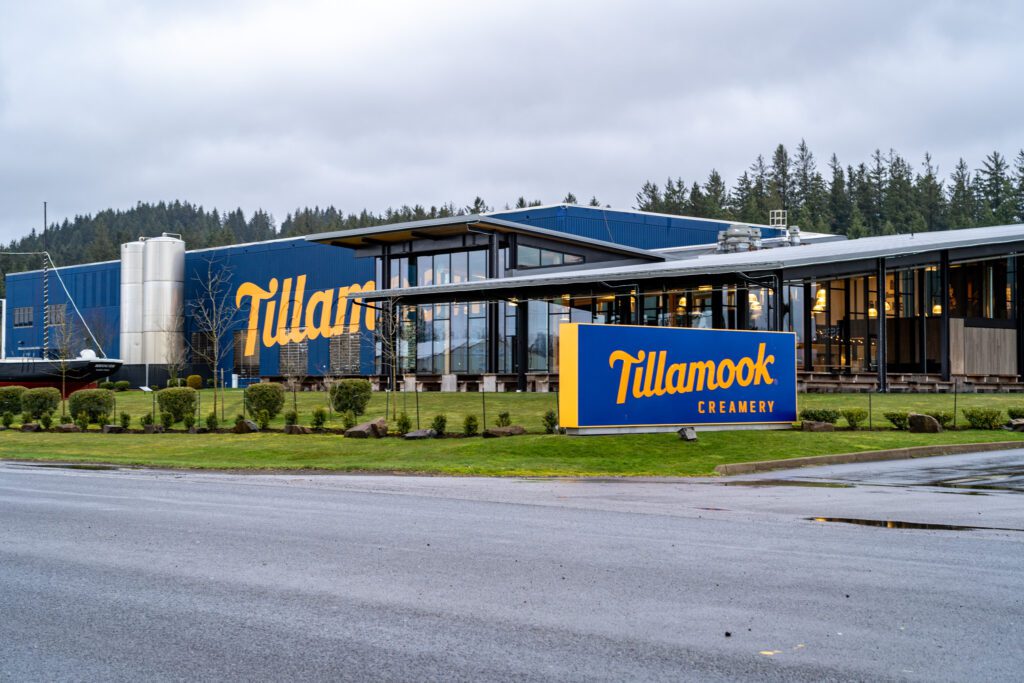
If you live in Portland, you are almost certainly familiar with Tillamook cheese and/or ice cream, which is synonymous with the Pacific Northwest at this point.
Their factory in Tillamook is a really fun pit stop, where you can learn about the cheesemaking process and, more importantly, buy and try their cheese and get a scoop of their ice cream (Alysha’s favorite is the chocolate peanut butter, with those thick ribbons of peanut butter).
They make cheese curds that are both delicious and also only sold at the factory, so stock up!
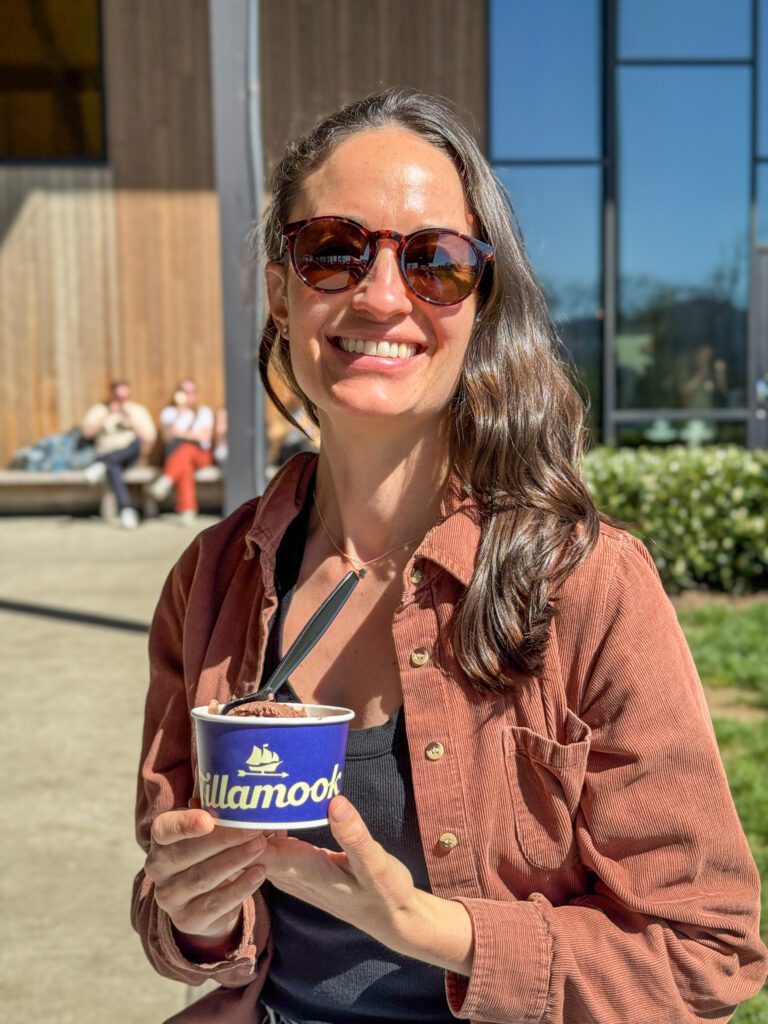
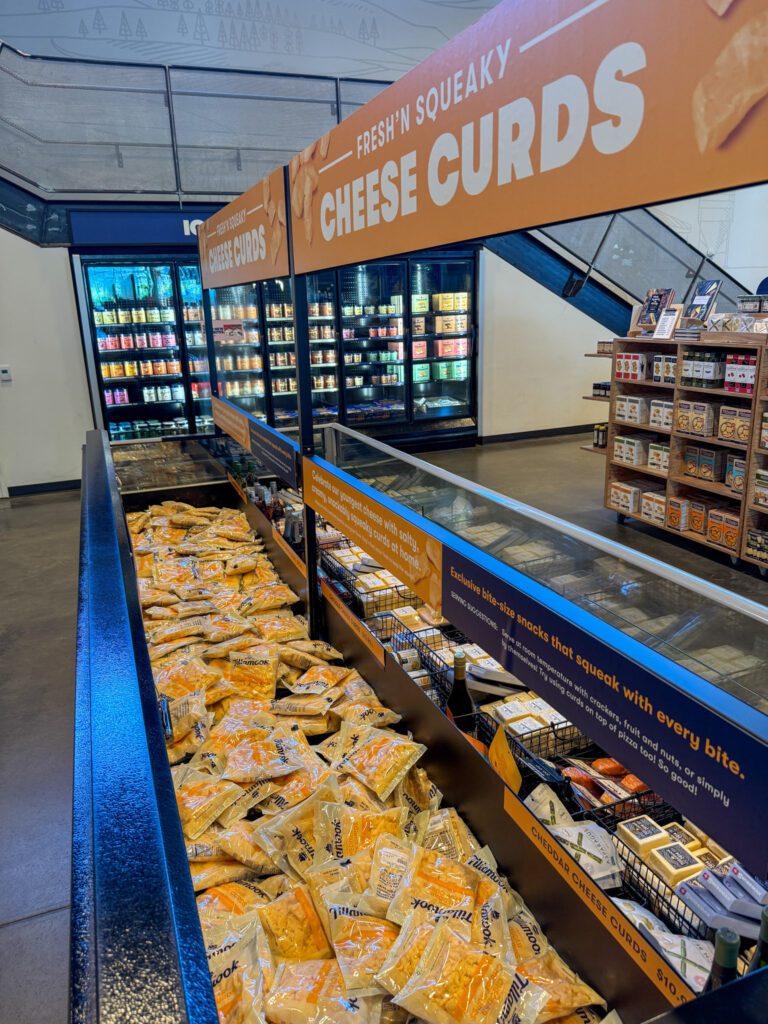
Cape Meares
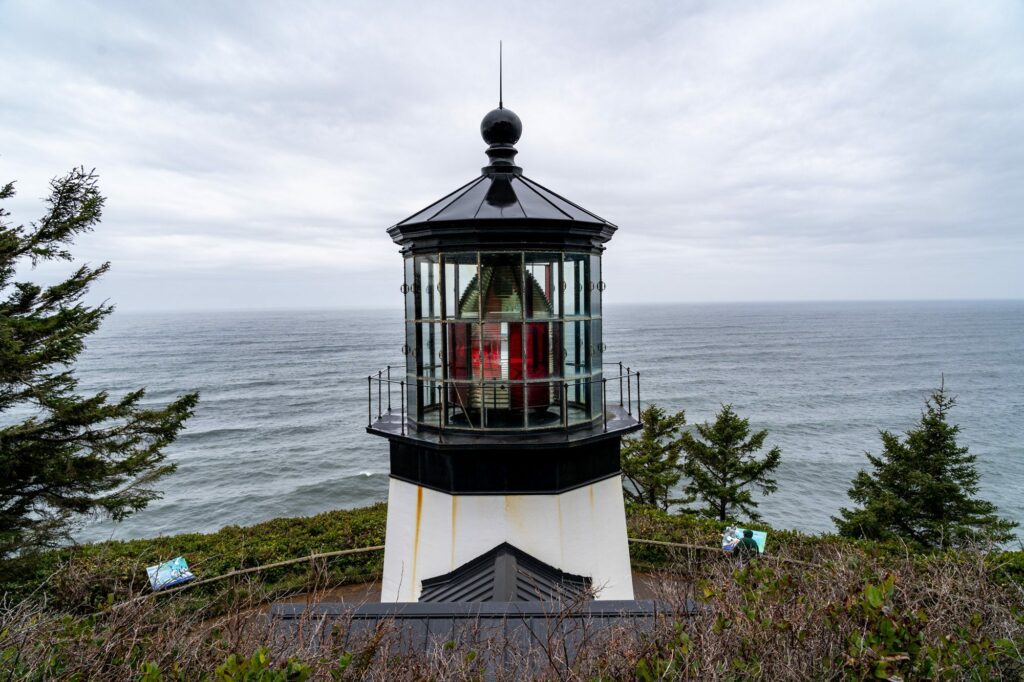
The furthest north of the Three Capes, this one is known for its small lighthouse (the smallest on the coast!). It’s also worth doing the short walk up to the Octopus Tree, and the view out over the coast nearby.
Cape Lookout
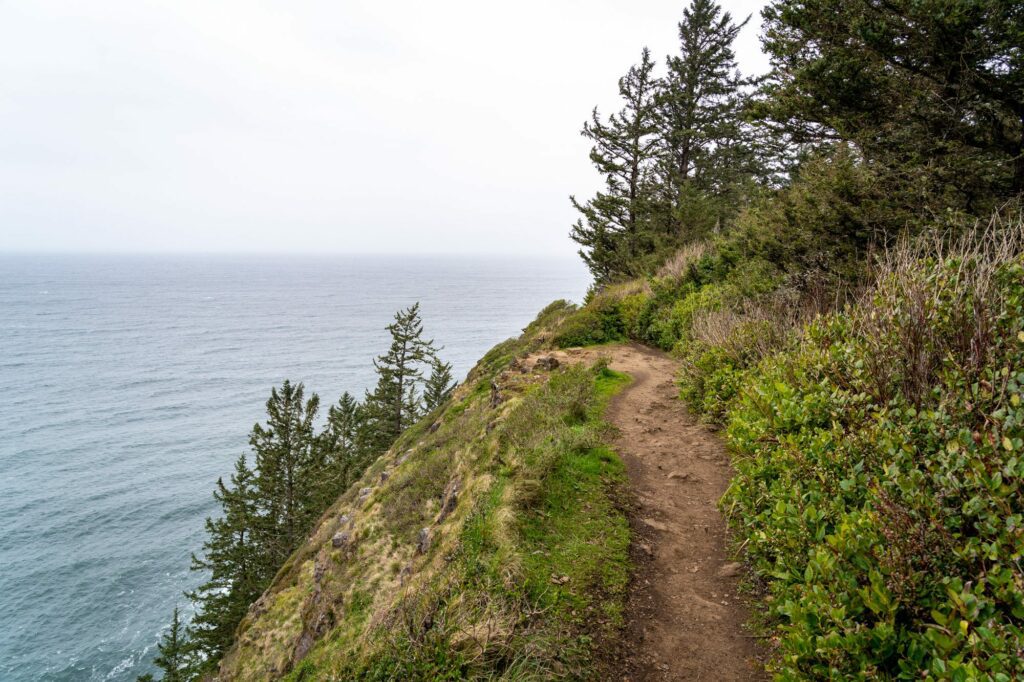
Our favorite of the three, the two main draws at Cape Lookout are the hike out on the cape, which is relatively easy and takes you out to the point where you can hear the sea lions frolicking on the rocks below, and the beach near the campground.
Cape Kiwanda

This is probably the most famous surfing spot on the northern Oregon Coast, and in the early morning you’ll find the waters full of surfers getting their fix in.
The thing to do here is to hike up onto the sandy bluffs on the north side of the bay for great views back over Cape Kiwanda and also out to the north.
Hiking near Lincoln City
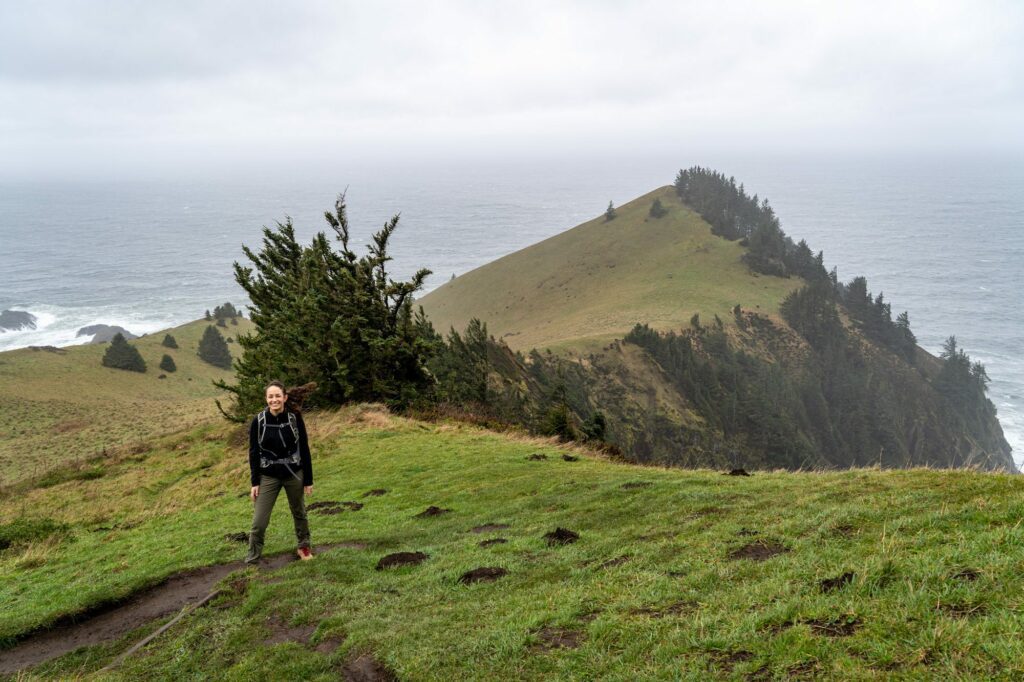
Two of our favorite hikes in Oregon – Cascade Head and God’s Thumb – are about 20 to 30 minutes south of Pacific City, and are worth the detour.
Both offer excellent views of the coast with relatively low effort. Cascade Head takes you on a journey through the forest before emerging onto the bluffs over the ocean and climbing up to the top of the ridge, where the views get even better.
God’s Thumb is a hike that takes you to a rock formation that pops out over the coast, with great views in both directions.
Both hikes are worthwhile, though we’d give the slight edge to Cascade Head (plus, it’s closer to Pacific City).
Cannon Beach
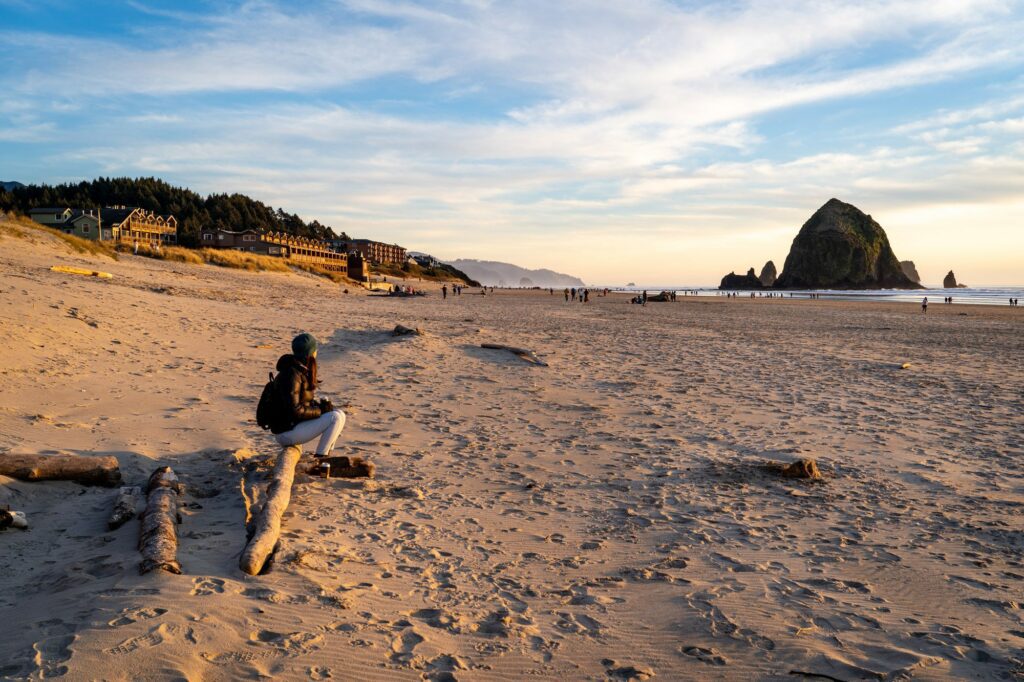
Cannon Beach is a funny little place.
On one hand, the town of Cannon Beach itself is fairly meh. There are some cool shops, but the majority are very much geared for tourists (think candy stores and fine art galleries).
But the natural beauty that exists in Cannon Beach and in the state parks to the north and south of the town is pretty spectacular, and that’s what we think makes Cannon Beach special.
One of the most iconic landscapes in the entire state is the looming form of Haystack Rock rising out of the ocean to tower over Cannon Beach.
Cannon Beach is the most popular town on the Oregon Coast, so you’re going to want to plan in advance if you’re coming on a weekend in the summer or fall.
We’ve stayed in Cannon Beach in the winter and early spring and loved it. It can be wet and rainy, sure, but it’s far less crowded than the peak summer months.
What to Do in Cannon Beach
Here are a few of our favorite things to do and see in Cannon Beach.
Admire Haystack Rock
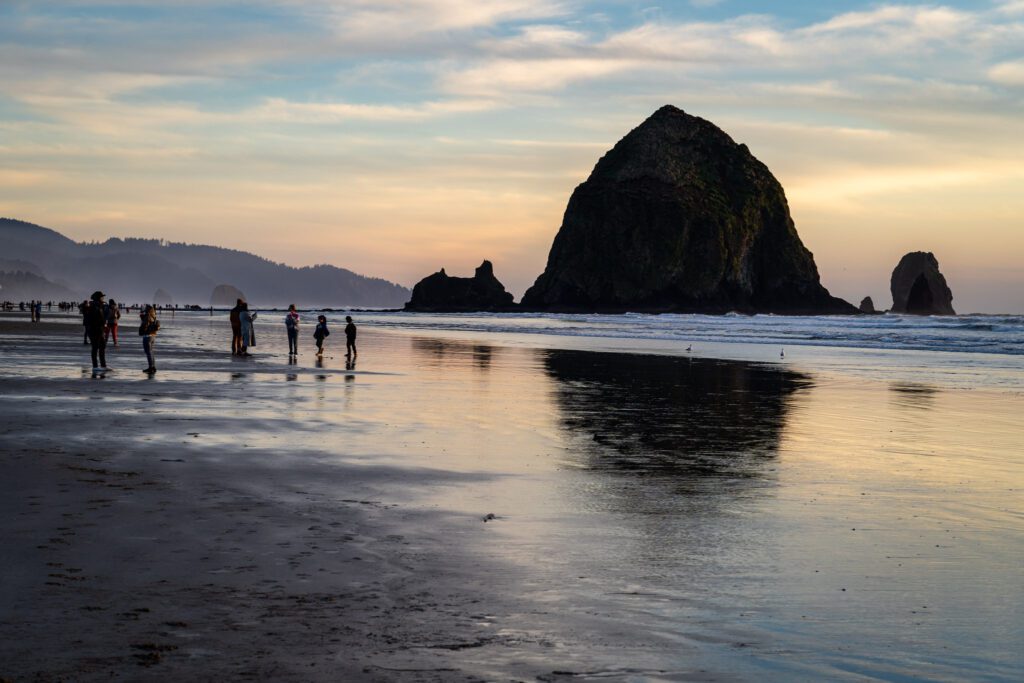
It’s popular for a reason. While you’re in town, you should absolutely head out to Haystack Rock to see it in person.
Go at low tide, if you can, which lets you get much closer to the base of the rock.
Plus, if you’re lucky, you’ll get a glimpse of the puffin colony (it’s worth talking to the rangers who are around to learn about them, if you can).
We’ve seen a pair of bald eagles raiding the puffin eggs and flying off while being attacked by the puffins. It was wild!
Explore the Town of Cannon Beach
The town of Cannon Beach itself is…fine. For us, it’s all about the access to the natural beauty nearby, and we don’t spend much time at all in town.
Here are some things to do around Cannon Beach.
Public Coast Brewing: Local beer, and gluten free fish and chips (though you’d never know it!) at the northern end of town near the entrance for Ecola State Park. A perfect post-hike refuel stop!
Good Coffee: If you’re in the mood for some good coffee, head to either Insomnia Coffee Co. or Sea Level Bakery + Coffee. Insomnia is right in town, Sea Level is about ten minutes south on the way to Oswald West State Park (and Sea Level is our top pick of the two).
Explore Ecola State Park
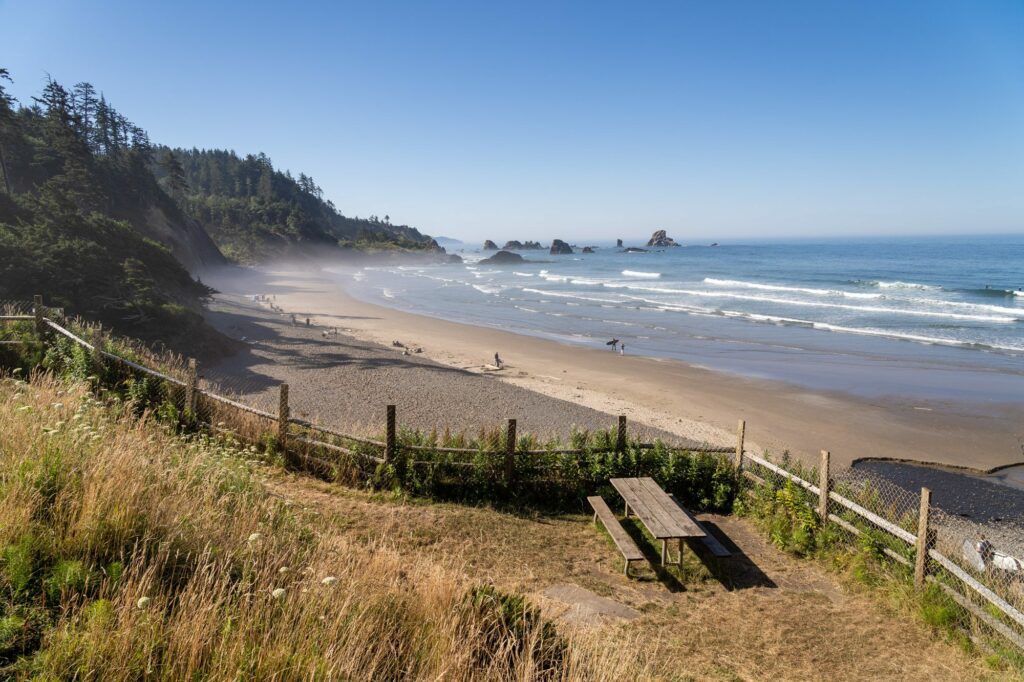
The state park on the northern side of Cannon Beach is accessed by a tree-lined, windy road that takes you out to two parking lots.
Our advice: park at the first parking lot if you can and hike first to Indian Beach and back (this is the best stretch of hiking in the park), then come back, have a picnic, and do the hike down to Crescent Beach.
Indian Beach is also a great place to lounge in the sun on a sandy beach, but you’re going to want to get there early on warm summer weekends, because it’s popular and parking is very limited.
Oswald West State Park
For this state park on the southern side of Cannon Beach we think your approach should be similar to Ecola.
Do one longer hike – either Cape Falcon (out to the tip of the cape on the north side of the cove) or Neahkahnie Mountain (switchbacks straight up, ending with a sweeping view out over the coast to the south) – then finish with the walk out to Short Sand Beach, a very popular surf spot that’s best at low tide.
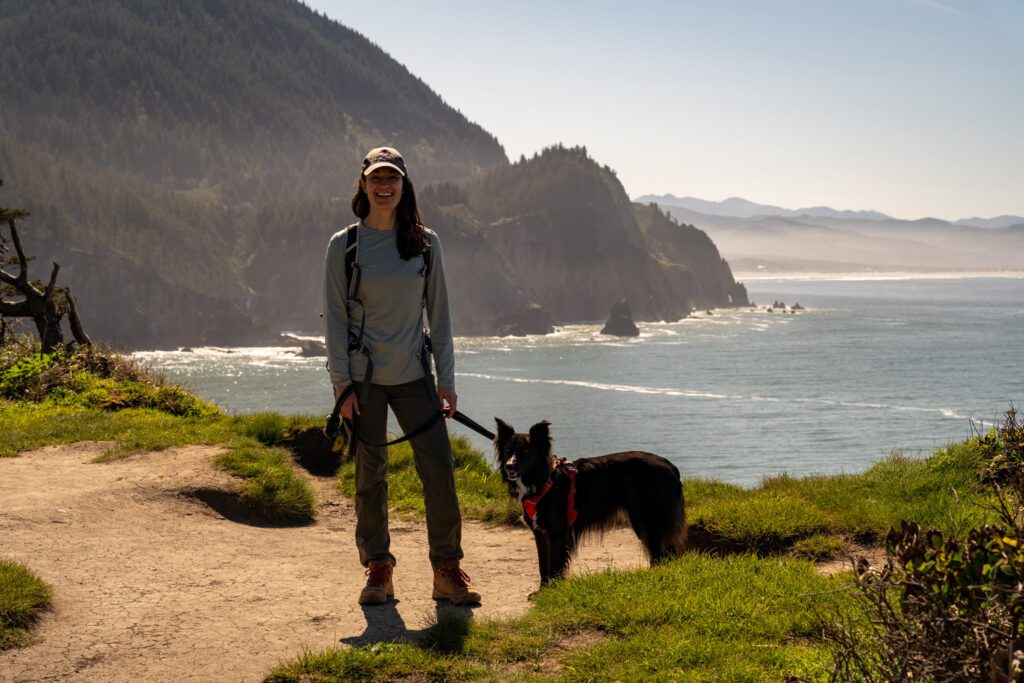
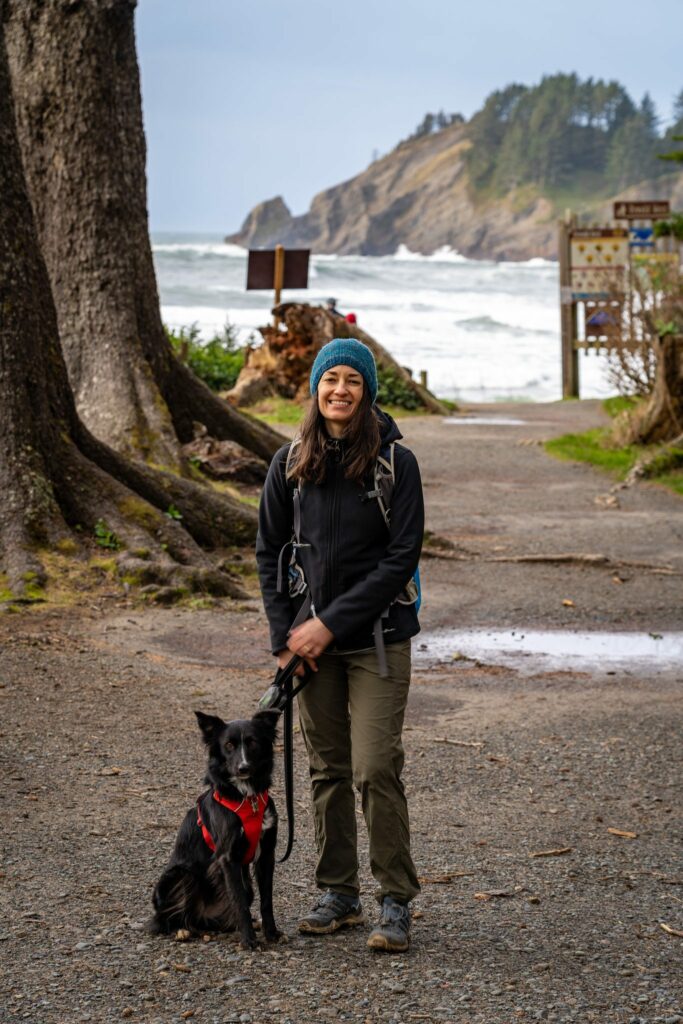
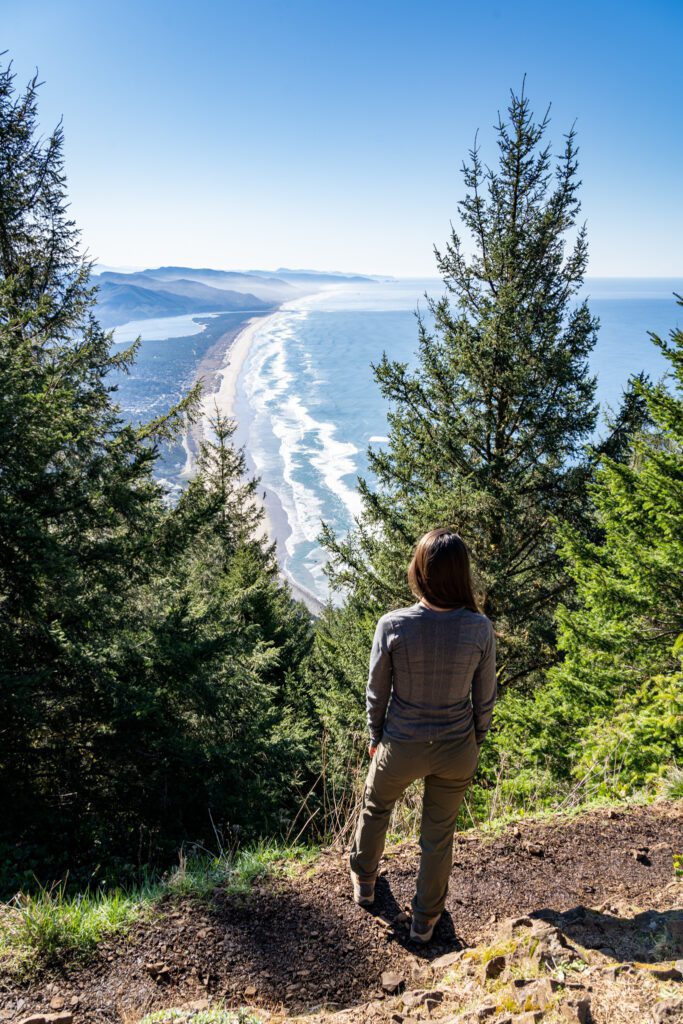
The Willamette Valley
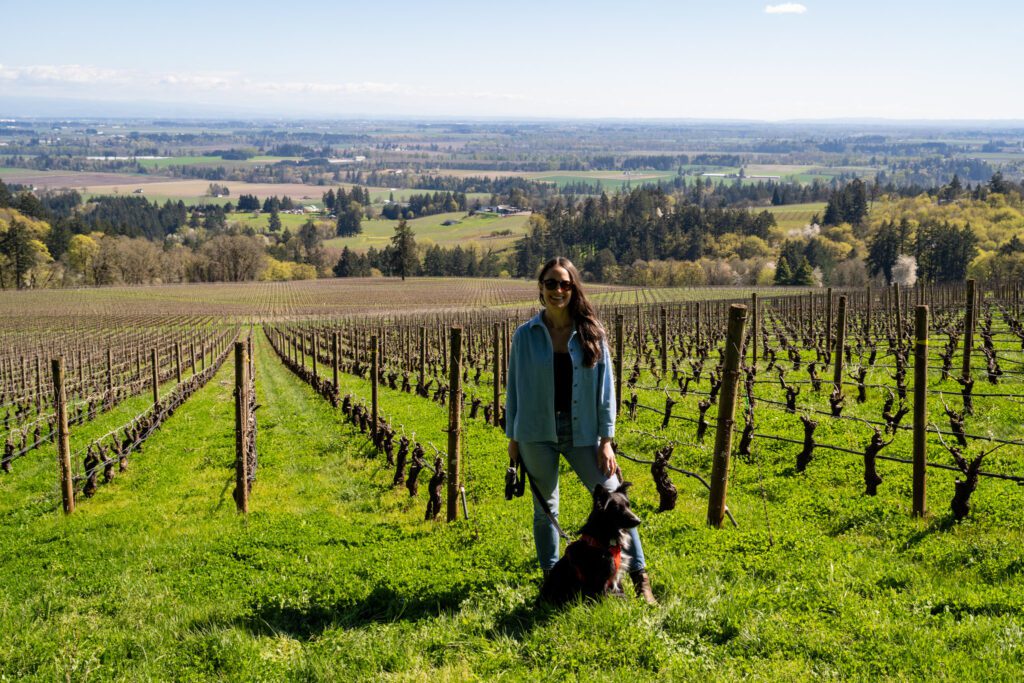
I didn’t quite understand just how world class the wines coming out of the Willamette Valley are until I found myself in Burgundy, France on a wine-focused trip in 2022.
Just about every time I told someone in the wine industry in Burgundy that I was from Portland, Oregon, they immediately said something along the lines of “oh, the pinot noir from the Willamette Valley is quite good, no?”
Turns out, Burgundy and the Willamette Valley are something like sister wine regions. They’re at roughly the same latitude, and the main grape varieties – pinot noir and chardonnay – are the same.
The other thing I have since learned about wine from the Willamette Valley is that the chardonnay here is NOT like the outdated picture I had in my mind about what chardonnay tastes like.
In my mind, every chardonnay was like the $10 bottle at Trader Joe’s that tastes similar to what I imagine getting smacked in the face with an oak tree tastes like.
So, when I declined a chardonnay at a tasting room in the valley, saying “I’m not a huge chardonnay fan because I don’t like the oaky, buttery thing,” the person said “oh, that’s not how we do it here.”
And that’s how I learned that not all chardonnay is a gross, oaky mess (no hate if that’s your thing, it’s just not mine).
All this is to say that there is some truly excellent wine coming out of the Willamette Valley, and a weekend is a good amount of time to spend to get a taste for it.
What to Do in the Willamette Valley
The Willamette Valley is a 150 mile long slice of land that basically runs from the Columbia River down to Eugene. Technically, Portland is part of the Willamette Valley.
But when we’re talking about the Willamette Valley as a Portland weekend getaway, we’re mostly referring to the area between McMinnville (or Dundee) on the north end, and Salem on the south end.
The two main towns – Dundee and McMinnville – are a good place to base yourself if you’re wanting the amenities of a city like restaurants, bars, grocery stores, and places to shop.
If you’re wanting to immerse yourself in the rolling hills and endless vines of the Willamette Valley, then staying somewhere more rustic might be a better bet.
McMinnville is a charming little town, centered around Third Street, the main commercial strip. It’s lined with places to eat and drink and small shops to poke your head into.
We like Third Street Books for, uh, books, and always stop by Alchemist Jam for their incredible fruit preserves with innovative flavor combinations that you can get slathered on freshly baked bread at their location in McMinnville.
However, you’re really here for the wine, right? So let’s talk about wine.
Oregon wine country is relatively young both when you compare it to the “Old World” (France, Italy, etc) and when you compare it to other wine regions on the West Coast, particularly in California. Wine has only been grown in Oregon for less than a century!
I, Matt, was absolutely flabbergasted when I was in Burgundy – one of France’s most prestigious wine regions – and, after telling them I was from Portland, they commented on how much they love Willamette Valley wines.
Turns out, the geography and climate are fairly similar, which is why the wines that come from the Willamette Valley are fairly similar to those in Burgundy.
Which is to say mostly chardonnay and pinot noir, the latter being the varietal that the Willamette Valley has become most famous for.
One thing to know about chardonnay here: it’s not the buttery, oaky chardonnay that you might find in California.
That particular style, I learned in both Burgundy and the Willamette Valley, gives chardonnay a bad name.
The chardonnay you’re likely to encounter here is light, bright, and fun!
Our advice for a weekend getaway to wine country would be to do somewhere between one to three tastings each day, and spend the rest of your time relaxing and enjoying the slower pace of life in the valley.
Here are a few places in the Valley that we love for wine, and think you will too.
Johan Vineyards: Our personal favorite of the many, many tasting rooms in the Willamette Valley. The tasting is a good value, and they generally have a few fun bottles open that they might let you taste. Their Jazzy Juice, a chillable red, and their pet-nats are our favorites of the wines they make.
Day Wines: They have a fun tasting room in Dundee where they have their low intervention wines for you to try, ranging from light whites and juicy rose to deep reds from grapes grown in southern Oregon. Nothing pretentious here – they’re all very approachable and drinkable, even if you don’t know much about wine (that’s us!).
Domaine Drouhin: Started by a winemaker from Burgundy, this is the place to go for a tasting that compares wine from the Willamette Valley and wine from Burgundy side by side, which is a fun way to do it.
Art + Science: Our favorite cider in the Willamette Valley! They make low-intervention wine, cider, and co-ferments of grapes and apples/pears that are delightful if you’re into bone dry cider. They have a tiny tasting shack in the middle of their orchard, and it’s only open on weekends in the summertime when they have events and live music.
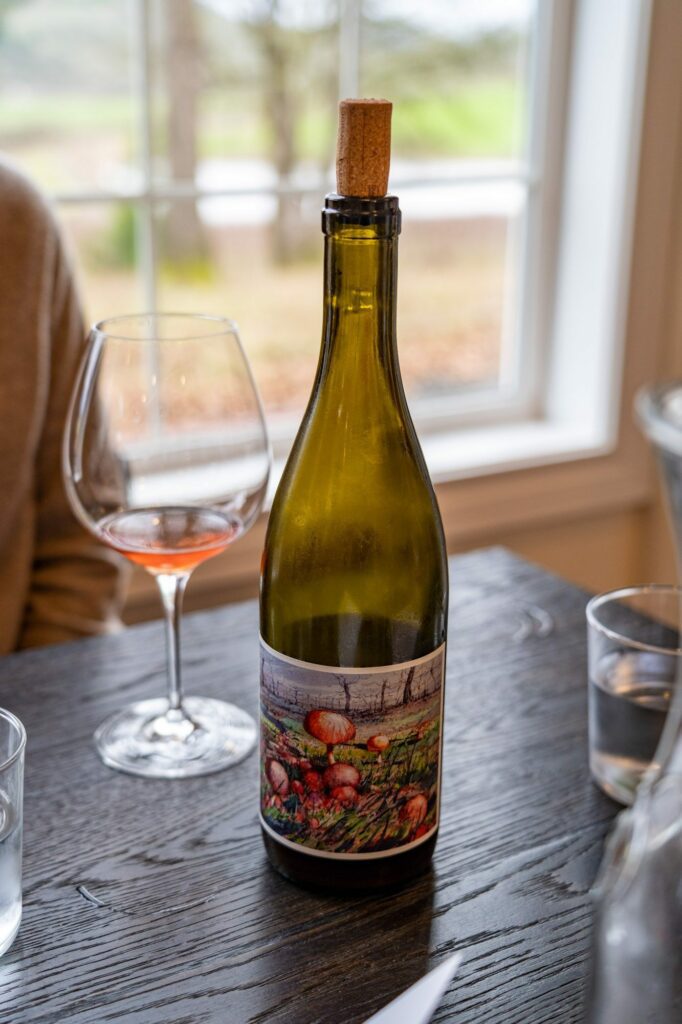
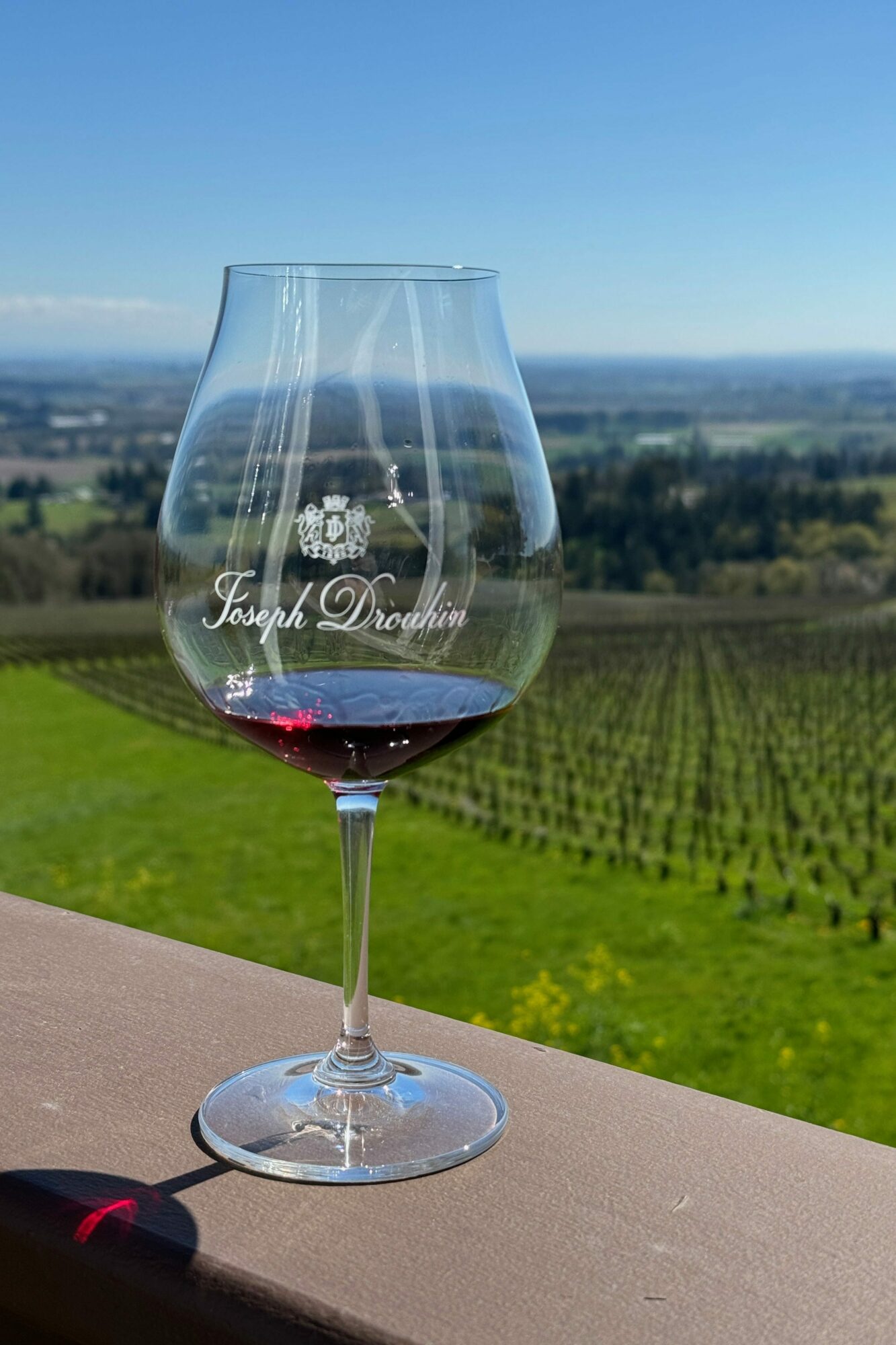
Crater Lake National Park
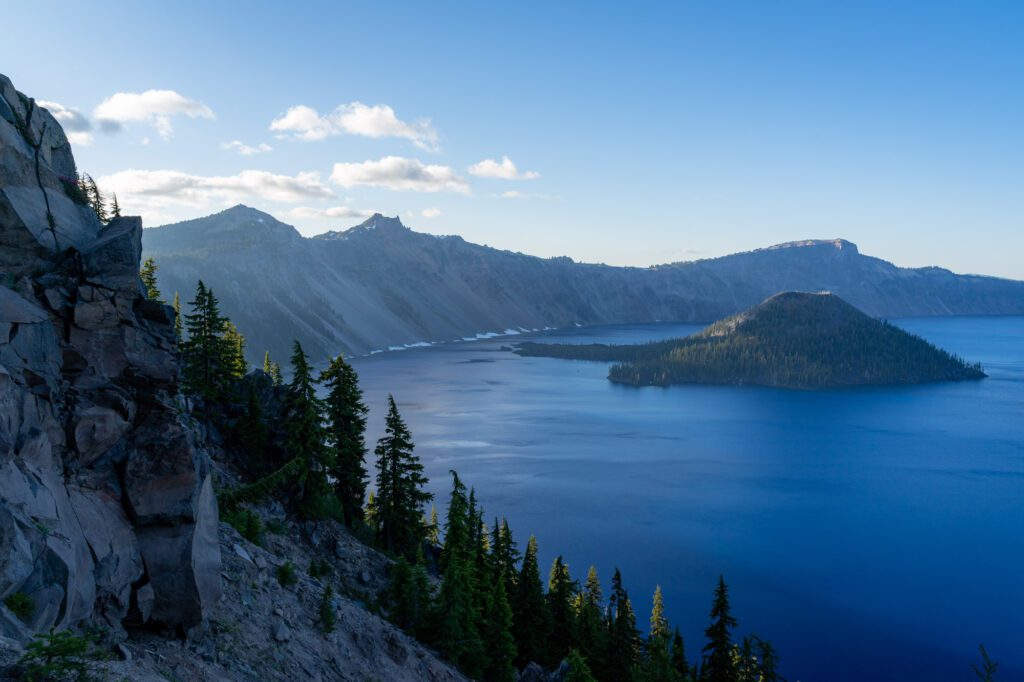
Over the past few years, we’re extremely lucky to have been to multiple places that make you consider what it must have been like to experience that place without any expectations.
Today, thanks in part to the internet and, before the internet was prevalent, travel books and travel photography, we generally have some idea of what to expect whenever we’re visiting a place.
We’ve seen countless beautiful photos of just about any place we’re going, and there are some places (like the Grand Canyon, for example) where we wish we could experience the pure euphoria of seeing something so majestic without the burden of expectations.
Crater Lake National Park is one of those places.
As we were circumnavigating the rim road, we talked about what it must have been like to be climbing through the forest and emerge onto the rim, accidentally stumbling across Crater Lake and seeing the massive caldera with stunning sapphire-colored water stretching out in front of you.
To be completely frank, Crater Lake National Park isn’t our favorite national park in the Pacific Northwest because it’s relatively small and limited in what you can do and see (which is why it makes a great 2-3 day weekend trip).
However, we do think it is certainly worth visiting once, and it’s the only national park in Oregon!
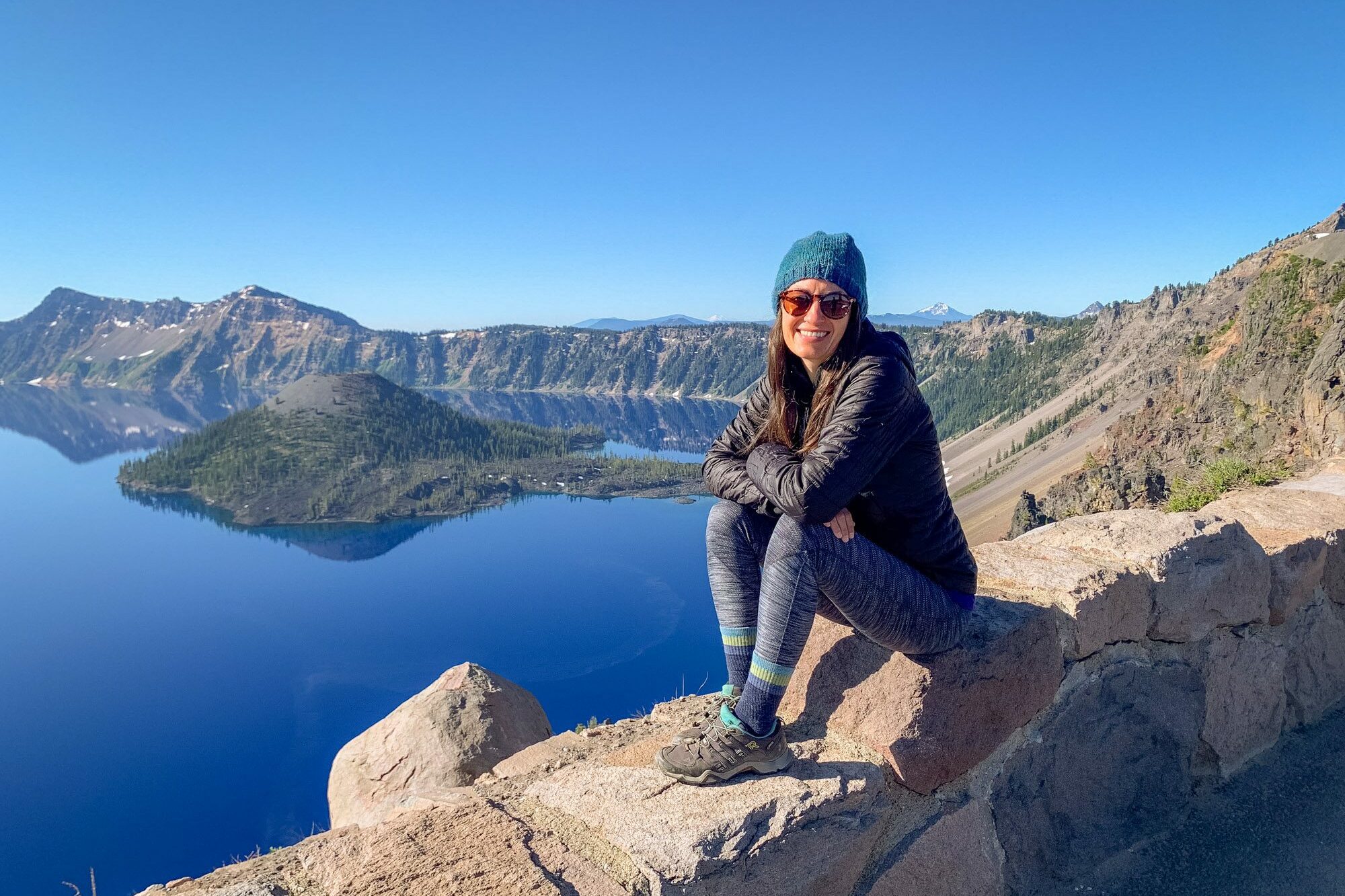
The biggest problem with Crater Lake is that it’s not really close to anything (which also presents a dilemma when it comes to where to stay, which we’ll get to below).
The closest major city is Bend, and that’s assuming you can call Bend a major city, which we’re not so sure about.
Even from Bend, it’s still a two hour drive to the main visitor center at Crater Lake (Rim Village on the south rim).
To get to Crater Lake from Portland, our favorite route is to head south on I-5 to Roseburg, and then cut over on Highway 138, stopping at Toketee Falls and Diamond Lake en route to Crater Lake.
This drops you on the northern rim of the lake, and you can head around the western rim to get to the visitor center.
From Portland to the south rim of Crater Lake, it’s going to be a five hour drive.
It’s a long one, but we’d say the sapphire blue water of Crater Lake will wash away your fatigue and exasperation of driving when you emerge onto the rim and get your first glimpse of the lake.
Part of the reason we wouldn’t recommend visiting outside the summer and fall has to do with road closures.
If you visit in the winter and spring, you’re likely going to have to drive all the way around to enter through the south entrance, which adds some time to the already long drive.
Plus, in the winter and spring, the eastern half of the rim road is closed, which makes it hard to access the best hike in the park (Mount Scott).
What to Do in Crater Lake National Park
To be honest, you probably only need a maximum of three days in Crater Lake National Park, which makes it an ideal weekend getaway destination.
Here’s what we think you should do in the park.
Hike to the highest point in the park
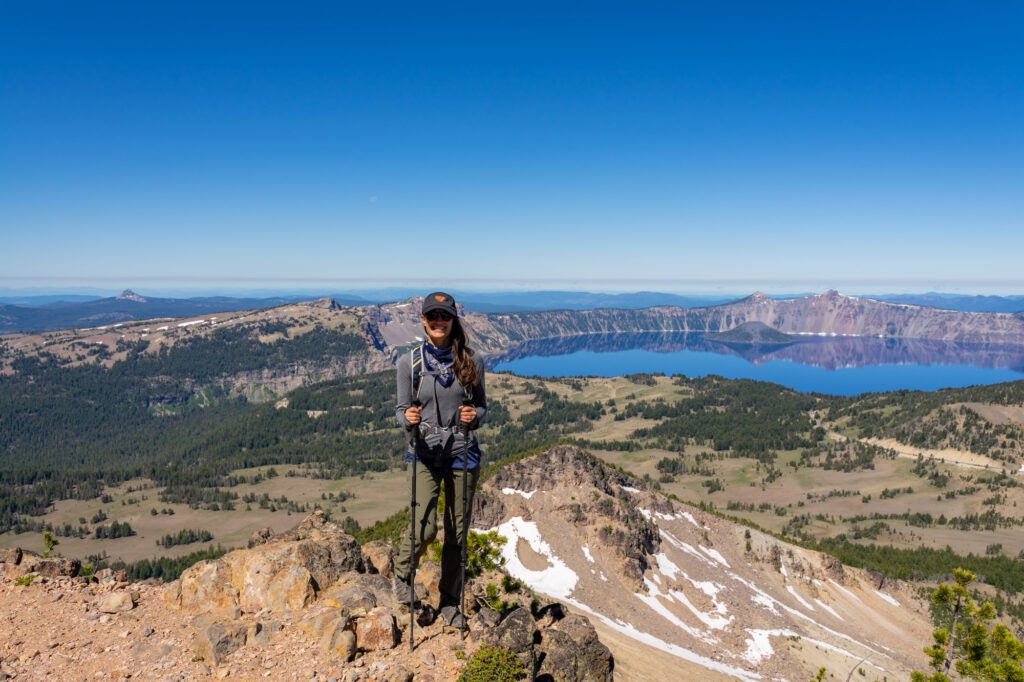
The highest accessible point in the park is Mount Scott, where you’ll find an old fire lookout perched on a ridge with excellent views of both Crater Lake and the surrounding landscape.
This hike is very, very exposed – there’s essentially zero shade from start to finish – so bring water and sunscreen.
It’s a moderate hike (4.2 miles / 1,200 feet elevation) and the views make the climb worth it, we think.
Hike to the lakefront at Cleetwood Cove
We like combining the hike to the top of Mount Scott with the hike down to the lakefront at Cleetwood Cove, which gives you two different perspectives in one day.
One from the highest point, and one from the lowest point (aka the lakefront).
This is also a moderate hike (2.0 miles / 600 feet elevation gain), and it’s truly straight up and straight down from the parking lot.
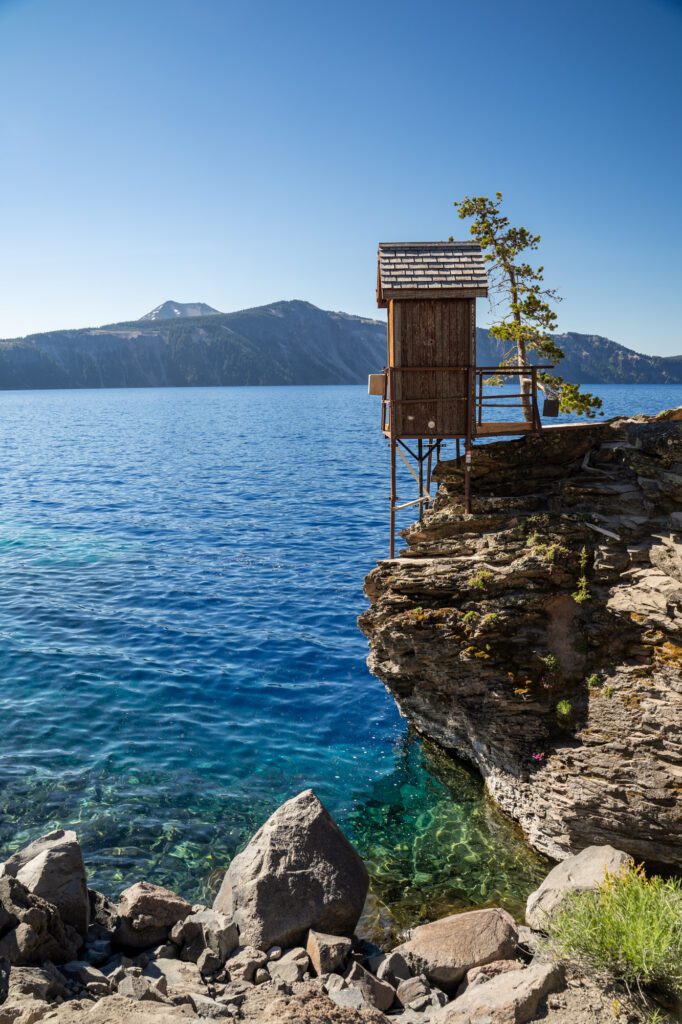
But taking a dip in the crystal clear water of the lake makes it well worth the effort.
Catch a sunset over the lake
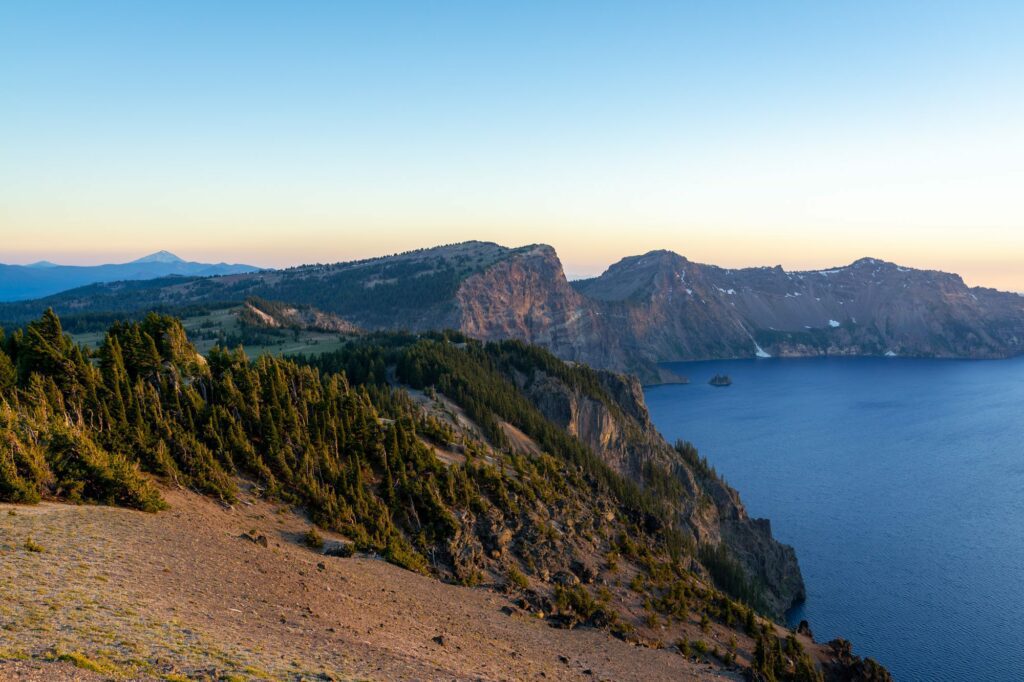
The way that the sun sets over the western rim of the lake, bringing a brilliant orange glow over the walls of the crater, is nothing short of magical.
Witnessing a sunset for yourself should be one of the major pieces of your Crater Lake National Park itinerary.
Ideally, you’ll hike up to Garfield Peak, which is on the southern rim and gives you a panoramic view of the lake, including the setting sun and the opposite rim where you’ll get that sweet orange glow.
Alternatively, you can hike up to Watchman Peak on the western rim, but the sunset will be behind you (this is a better sunrise spot, we think).
For a nice view without a hike, head to this overlook, where we caught a beautiful sunset on our last trip.
Drive the entirety of the rim road around the lake
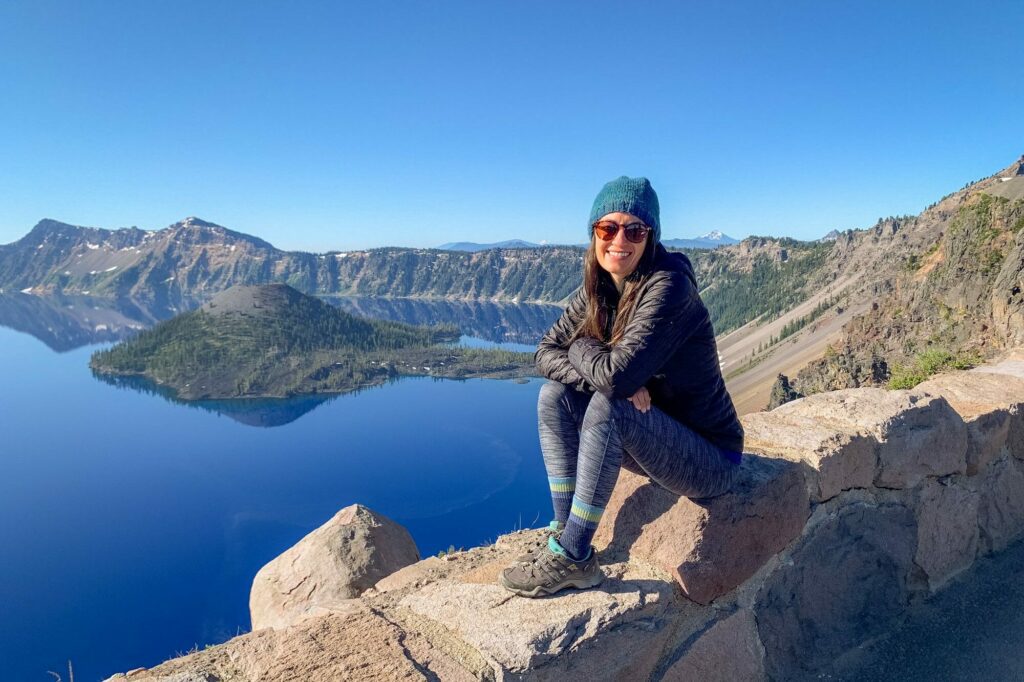
The drive around the lake is a must-do, especially if you’re able to do it either early in the morning (pre-9am) when there are far, far fewer cars on the road, or in the evening.
Seeing the lake from different angles and with different lighting is amazing, and it’s fun to see the water go from sapphire blue to crystal clear and bright blue depending on what angle you’re seeing it from.
Sisters
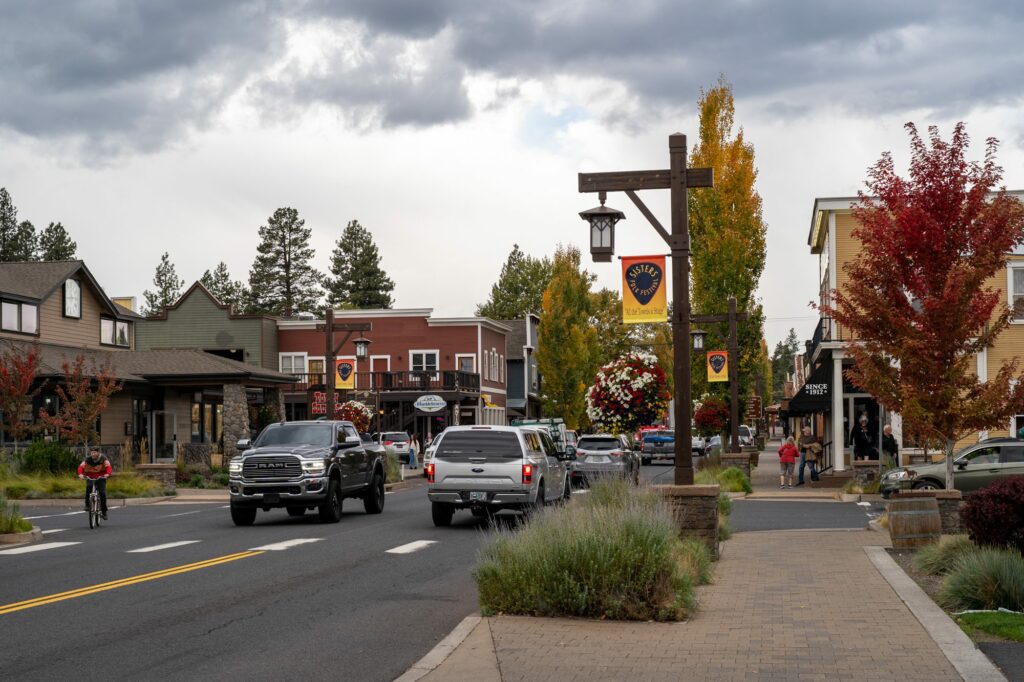
At one point, we grouped Sisters and Bend into one category, thinking “oh, they’re pretty close together, they don’t need to be separate destinations.” Same vibe, right?
However, after a few trips to Sisters, we decided to add it to this list because it is very much a different vibe and set of attractions than what Bend has to offer.
Sisters itself is a charming little town that was either built or remodeled to have a Western theme, but when we go to Sisters, we rarely spend more than a few hours walking around town (it’s very compact).
The real magic happens outside of the town itself, where you’ll find mountains, mountain views, the Metolius River, lakes, and more.
Using Sisters as a home base gives you relatively easy access to the surrounding areas, which include some of our favorite places to visit in Oregon.
What to Do in Sisters
Here are a few of our favorite things to do in Sisters.
Hike in the Cascades
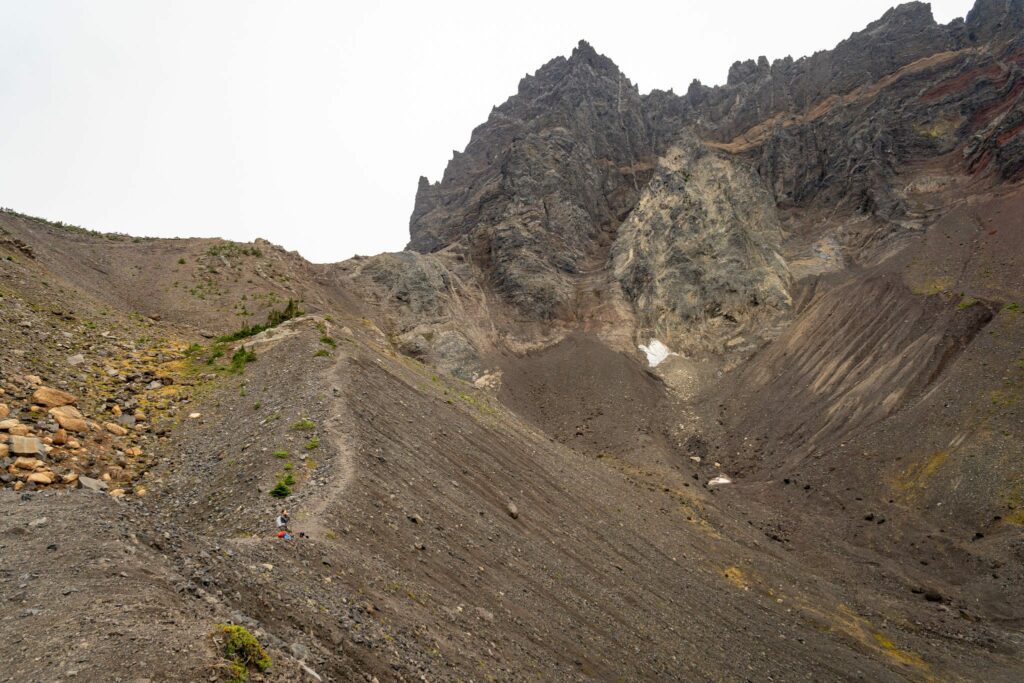
If you’re here in the summer, you’ll find a nearly endless number of hikes for a variety of different fitness levels, from multi-day backpacking trips to short walks around a lake.
We have a couple of recommendations for you, obviously. First is Canyon Creek Meadows, which we tackled on our latest trip to Sisters and, though the weather was strictly okay (it rained A LOT later that afternoon), it was still a lovely hike that takes you up to the base of Three Fingered Jack.
Second is the Iron Mountain / Cone Peak Trail, which was one of our very first hikes in the state and remains one of our favorites to this day thanks to the excellent panoramic views from the summit and the amazing wildflower displays in the early summer.
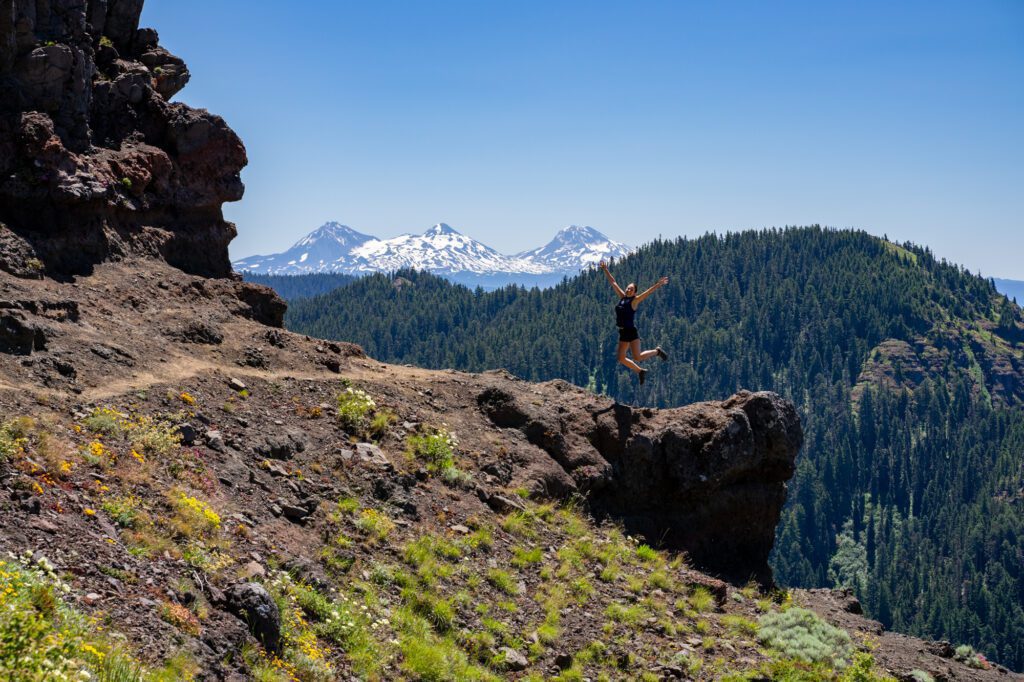
Meander around Sisters
As we mentioned, we don’t spend a whole lot of our trips to Sisters in Sisters itself. But we DO always stop in town to walk the short little loop.
Matt loves Sisters Coffee, and it’s usually our first stop in town.
The Barn in Sisters is worth a stop for lunch – it’s a collection of food carts set around a bar (in a barn).
Other notable stops are Sisters Bakery for pastries, and Sisters Meat and Smokehouse next door for sandwiches and a small gourmet food shop.
There are also some good bookstores, art galleries, and other odds and ends that are fun to peruse.
Drive the Mckenzie River Scenic Byway
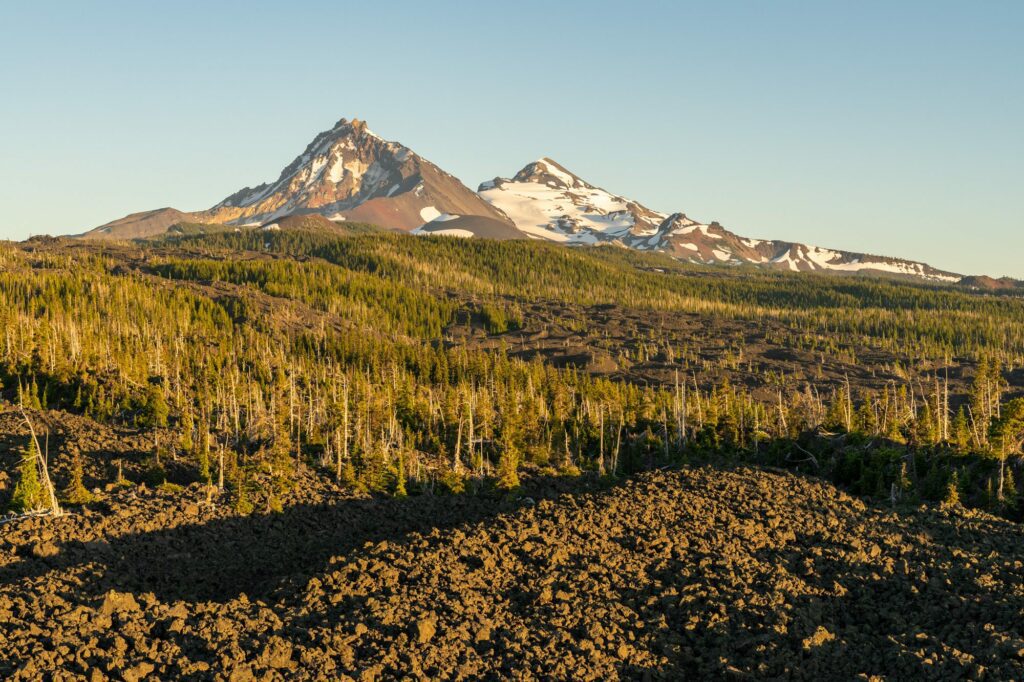
Our favorite scenic drive in Oregon! This drive is nothing short of spectacular, but it is ONLY doable in the summer because the extra scenic part of the drive – Highway 242 – is closed seasonally (when you drive it, you’ll see why).
Here’s a map of a loop that starts and ends in Sisters that we’d do, along with all of our favorite stops.
In particular, we wouldn’t miss Sahalie Falls (which is on the McKenzie Highway, technically not part of the Scenic Byway), Proxy Falls, Scott Lake, and the Dee Wright Observatory.
Explore the West Metolius River
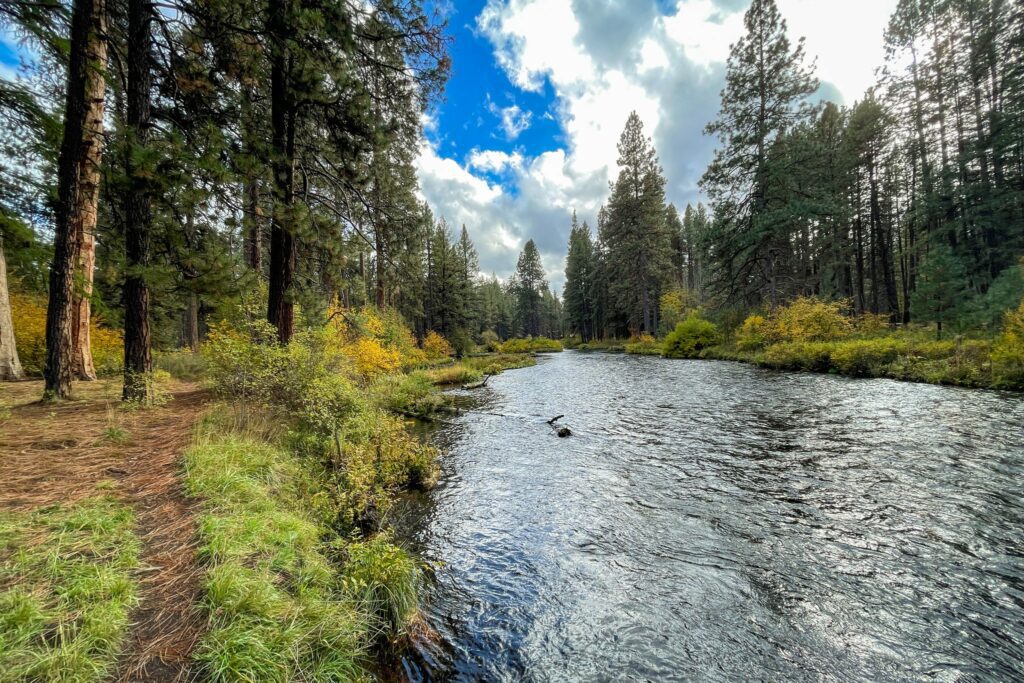
This was a surprise for us, because while we’d heard of the Metolius River before, we had never considered actually visiting it (we’re not into fishing, which seems to be the primary recreation on the river) until we found ourselves within 15 minutes of it.
Turns out, we should have visited sooner! It’s a beautiful area, and there’s a really nice and easy loop along the riverbank that is well worth doing (the trail continues north from the end of that particular route, but leaves the river for a bit before picking it back up).
Seattle, Washington
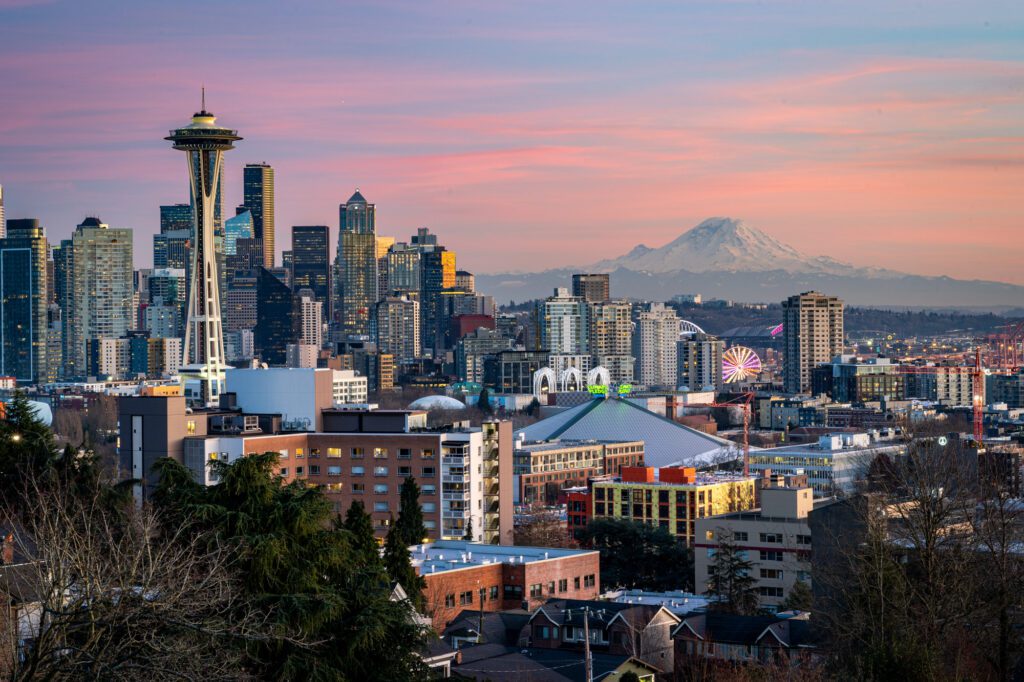
This section is going to seem a little biased, and that’s because Matt grew up there and still loves the Emerald City (don’t worry, I’ve adopted the Timbers and root for them over the Sounders!).
Seattle is a city that has gone through significant shifts and changes over the past decade or so with the rise of Amazon (though Seattle’s history is just one big sequence of major shifts), which is headquartered in Seattle’s South Lake Union.
Still, regardless of how we feel about Amazon (spoiler: not great), Seattle is a wonderful city that’s worth your time.
It has a strong culture scene, with a neverending list of shows and productions coming through town, and some fantastic neighborhoods to explore (we love Capitol Hill and Ballard).
In the same way that Portland comes alive when the sun is out, Seattle is at its best in the summer and fall, when days are long, Mount Rainier is visible from all corners of the city, and the calendar is packed with events from block parties to farmers markets.
Plus, it’s one of the only getaways from Portland on this list that you can actually do by public transportation, which is WILD (more trains, please!).
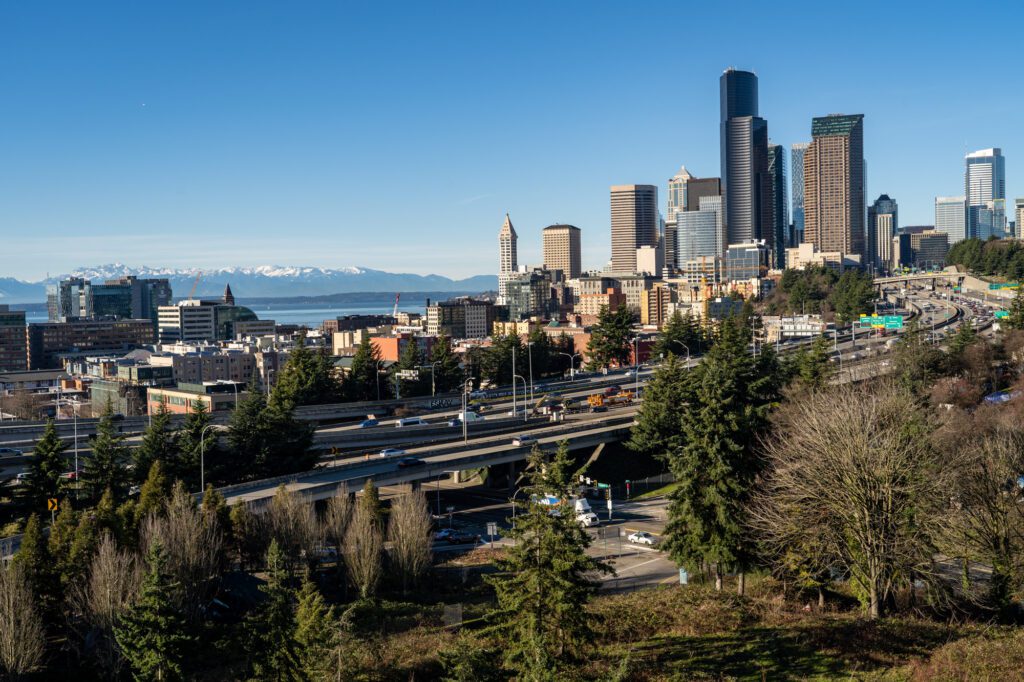
Getting From Portland to Seattle
Kind of like visiting Portland, you probably don’t need a car while you’re in Seattle, and it’s likely to be more of a hindrance than a help in most cases (not to mention an expense because you’re almost certainly going to have to pay to park).
For that reason, we’d strongly recommend taking the Amtrak Cascades between Portland and Seattle, which is what Matt has done many times to go back to visit family.
It’s only slightly longer than the drive (assuming no traffic, which is almost never true), and you can sit back, relax, and read/catch up on your favorite show/scroll TikTok for a few hours.
If you do decide to drive, it’ll take about two and a half or three hours without traffic.
However, there is almost always traffic, especially passing through Olympia (and Joint Base Lewis-Mcchord) and Tacoma, so if you can leave midday to get through those areas between 12pm and 3pm, do it!
What to Do in Seattle
Seattle is a great city, and a few days is nowhere near enough time to explore every corner of it.
Like Portland, it’s a city split between the downtown core (similar vibes to the west side of the river in Portland, with a downtown area and some cool adjacent neighborhoods) and the more residential areas beyond (like the east side of the river in Portland).
Both are well worth your time, but with just a two or three day trip, you’re going to be hard-pressed to make it to all of the different neighborhoods.
We’d focus your time on the three neighborhoods in the downtown core: Downtown Seattle, Belltown/South Lake Union, and Capitol Hill.
Here are some of our favorite things to do and see in those areas.
P.S. we have a ton of guides to Seattle to help you plan your trip, including a guide to spending a weekend in Seattle and a guide to figuring out where to stay in Seattle. Read those for far more detail than you’ll find in this section.
Explore Pike Place Market
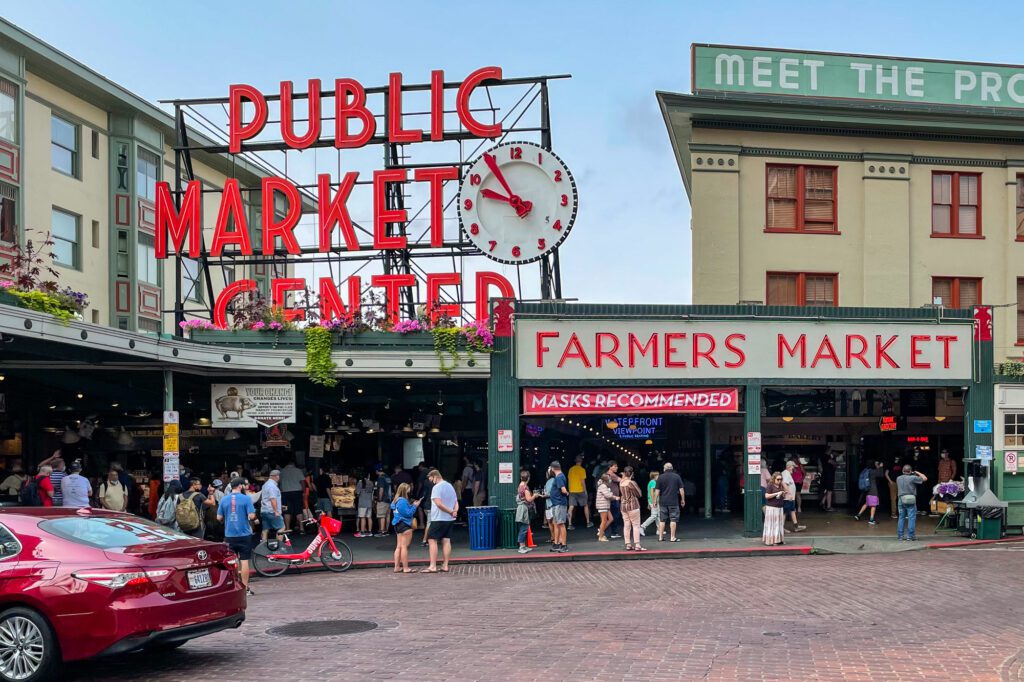
How could we not start with Pike Place Market (which is both a huge tourist trap and also well worth a visit)?
There are some truly great places to eat and drink at the market, and the best way to find them is to wander a bit (we like Beecher’s for the cheese, which you’re probably familiar with if you live in Portland, Piroshky Piroshky, and Rachel’s Ginger Beer).
If you really want to get into the food scene, take this food tour, which my mom and brother have done as a birthday gift and enjoyed.
Whatever you do, DO NOT wait in line at the “original” Starbucks, which is not in fact the original, and is no different than any other Starbucks in the country. Seriously. I cannot believe people wait 45 minutes in line to go here.
Head to Victrola Coffee or Ghost Alley Espresso right near the market instead!
Wander Around The Seattle Center
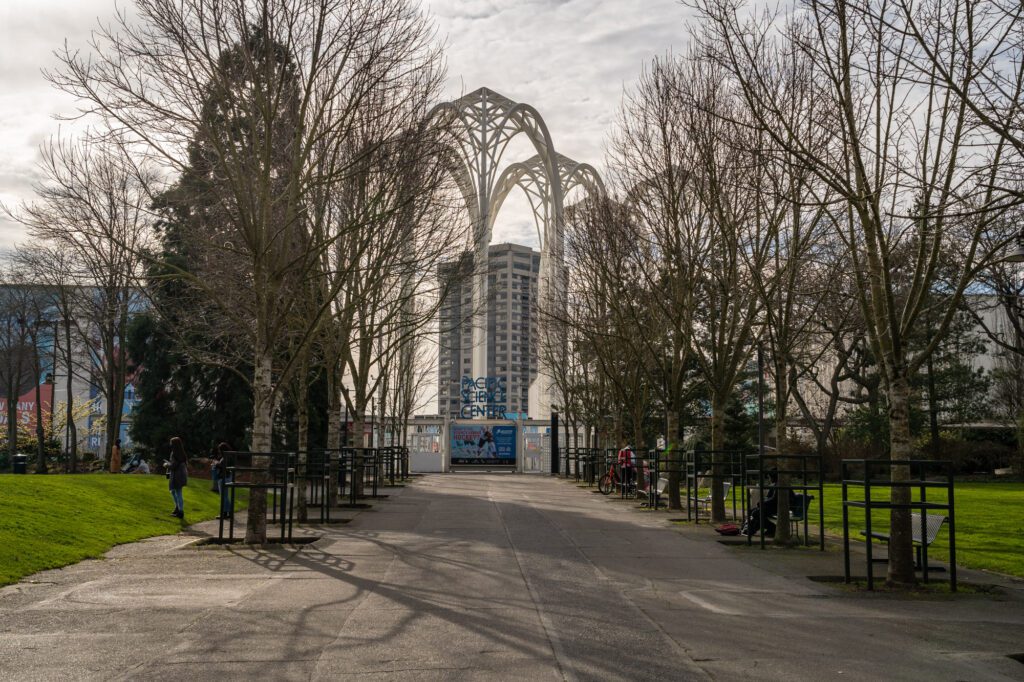
First of all, Seattle Center is a complex of attractions located in Queen Anne, not the geographical center of Seattle.
There are really three things worth doing at Seattle Center:
- The excellent Museum of Pop Culture (lots of good music-related exhibits around Seattle’s role in the grunge scene
- The Chihuly Gardens and Glass (Dale Chihuly was a mastermind when it comes to working with glass)
- Caffe Vita at KEXP (the coolest setting for a coffee shop in Seattle, where you can sip your drink right outside the recording studio for Seattle’s alternative radio station, KEXP).
The thing not worth doing? Going to the top of the Space Needle.
It’s ridiculously expensive ($40+ a person at the time of writing) and the view is missing a key piece of the skyline…the Space Needle! Skip it.
Kerry Park for Sunset
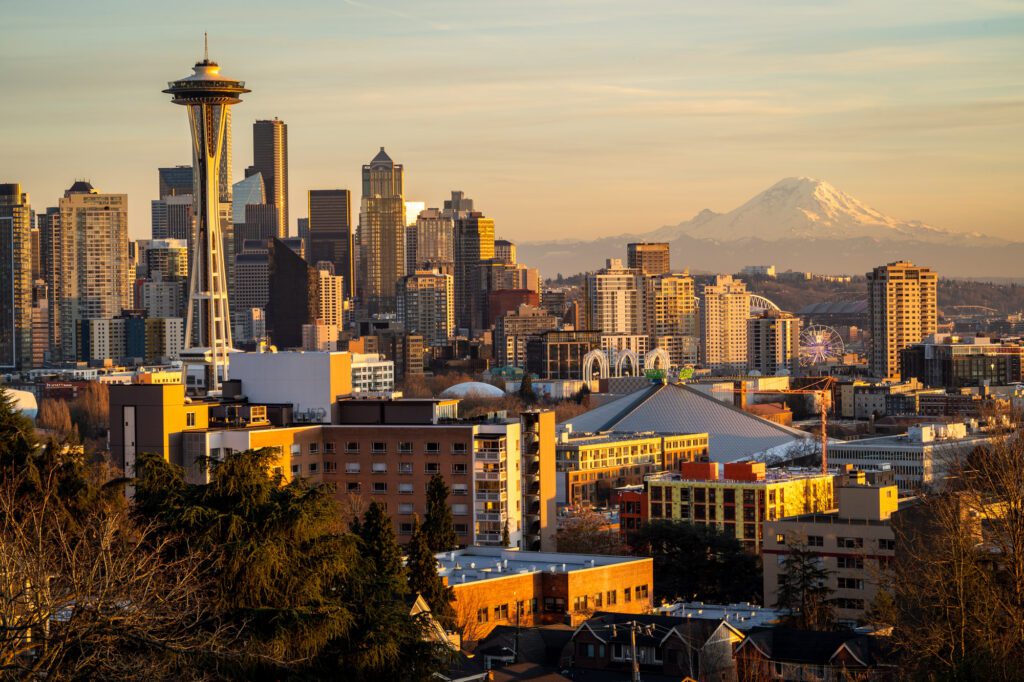
The reason we don’t recommend that you go up the Space Needle is that there is a perfectly lovely viewpoint 10 minutes away that is free, and INCLUDES the Space Needle, which is an iconic part of the Seattle skyline.
Plus, a view of Mount Rainier and Elliott Bay on a clear night!
This is the most popular sunset spot in the city, so don’t expect to be alone up here. We bring all the friends and family who visit us in Seattle here.
You can find it here on Google Maps.
Explore Capitol Hill
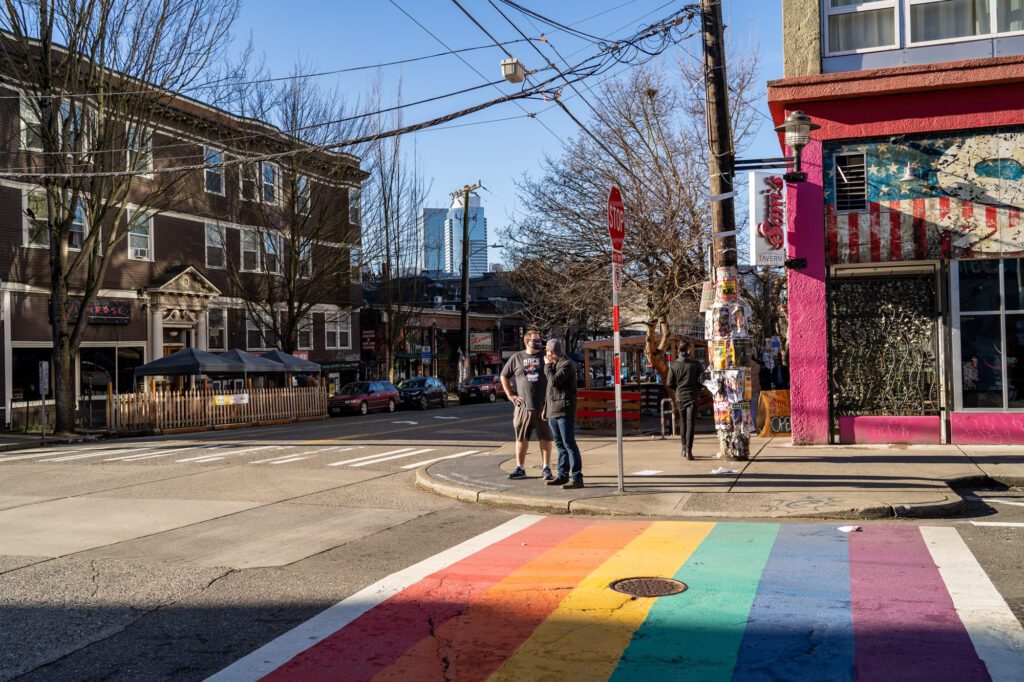
Capitol Hill is easily one of the most vibrant neighborhoods in Seattle, and we consistently find ourselves coming back here every time we’re in town, either to eat or drink, or just to soak up the vibes.
Historically, it was the most LGBTQ+-friendly part of the city, and while that’s still true today, it has shifted more towards the yuppie end of the spectrum in the past 5-10 years with the huge influx of tech money.
Still, it’s well worth a visit, and we’d probably make it an afternoon/evening jaunt to take advantage of food and drinks.
Shop at Elliott Bay Books (the Powell’s of Seattle), eat Seattle’s iconic ice cream around the corner at Molly Moons (or Frankie and Jo’s nearby if you want plant-based ice cream), and stroll Pike Street.
For drinks, go to Canon or Tavern Law for cocktails and impressive whiskey lists, or to Outer Planet Brewing for one of Seattle’s best breweries.
Take the ferry to Bainbridge Island
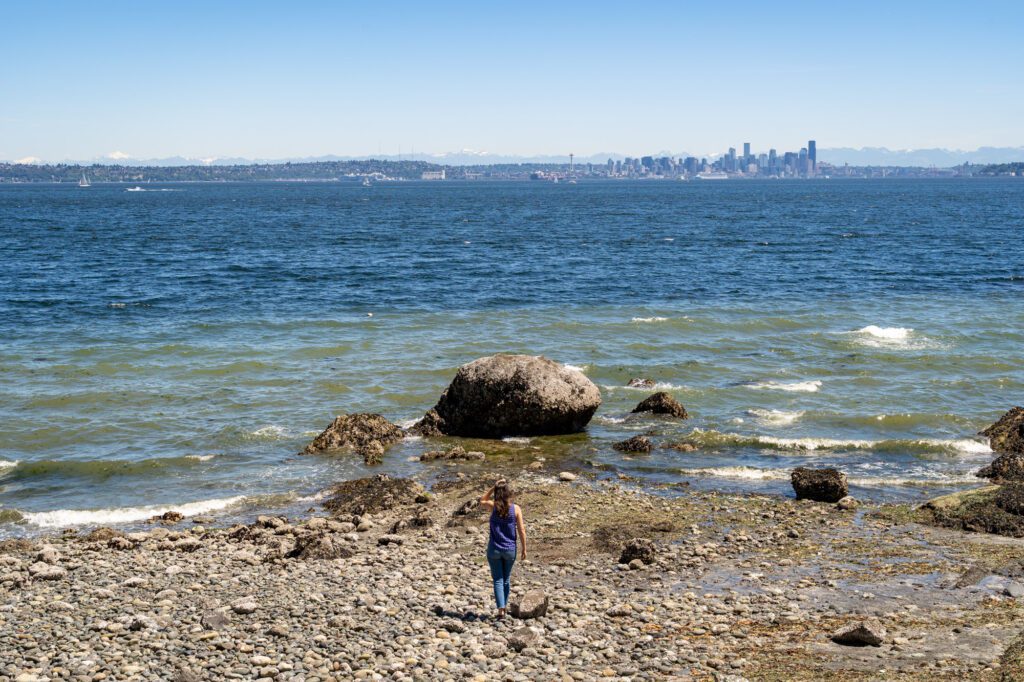
One of the unique things about Seattle’s geography is the fact that it is right on the water, but not the ocean.
The Puget Sound separates Seattle from the Olympic Peninsula, and we LOVE taking the ferry over for a day trip to Bainbridge Island (and you don’t need a car, but you can take one on the ferry).
The ferry ride leaves from downtown Seattle along the waterfront, and embarks on a picturesque journey across the Sound that includes (on a clear day) all three major mountains in Washington State: Mount Olympus (and the rest of the Olympic Range), Mount Rainier, and Mount Baker.
Once you’re on Bainbridge, walk down the main strip (Winslow Way), do some window shopping, and eat at Blackbird Bakery (great baked goods) or Proper Fish (proper fish and chips, down to the newspaper wrapping and the mushy peas).
Mount Rainier National Park
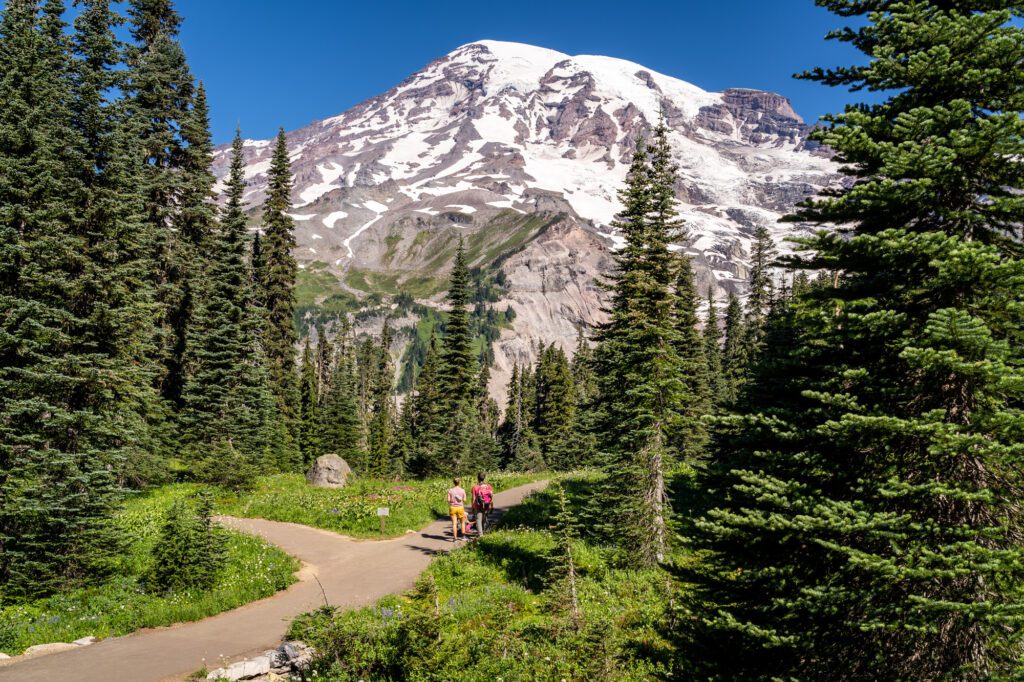
Ah, Mount Rainier! Matt grew up in the Seattle area, and his affection for Mount Rainier is similar to a lot of Portlanders and their love for Mount Hood.
Basically, Rainier (and Hood) are strongly associated with summer and nice weather, because the barometer of a good day in Seattle is whether or not “the Mountain” (meaning Rainier) is out.
The thing we love about Mount Rainier – and what we think makes it special – is that, yeah, obviously it’s a massive mountain.
But the fact that the vast majority of the area west of Rainier in western Washington and Oregon is basically at sea level makes it a prominent feature of the landscape.
In fact – and I just learned this – it’s the most topographically prominent peak in the contiguous United States, which basically means the difference between the peak and the surrounding landscape is the greatest of any other mountain.
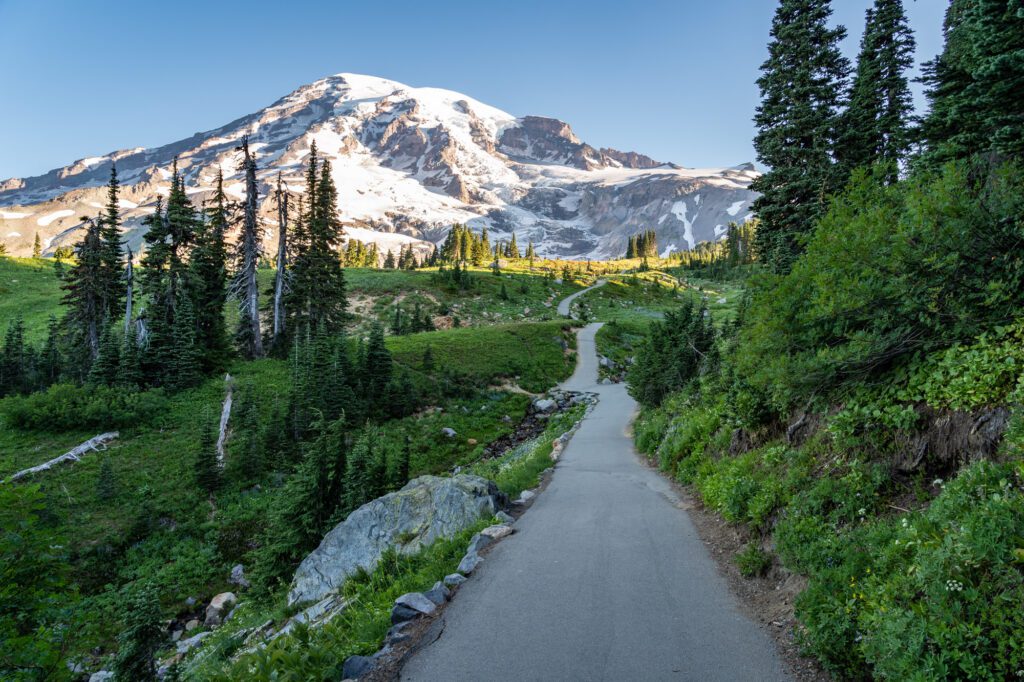
At 14,417 feet tall, it’s the highest peak in the Cascades, and it’s one of the best hiking destinations in the Pacific Northwest, especially in the early summer and fall.
Though, we should note, it’s definitely NOT off the beaten path – we’re pretty sure the beaten path runs right through it.
We think the hype is well earned, and have found ourselves hiking at Rainier each of the past three summers.
The downside is that, because it’s so popular, you will need to plan well in advance, so it’s probably not the best impromptu weekend getaway from Portland.
A note on when to visit: If you live in Portland you probably already know this, but at Mount Rainier, the word “summer” means something completely different than it does in most other contexts.
In Mount Rainier National Park, “summer” refers to the best time to visit for hiking and wildflowers, which is a relatively small window from late July through August. Before late July, higher elevation trails will likely be snow-covered and largely inaccessible without snowshoes and/or microspikes.
Wildflower season at Rainier peaks in the last week of July and first week of August, depending on the year. It’s a VERY popular time to be there.
Early fall is arguably a better time to visit for crowds, though the weather is going to be a little more unpredictable.
The first two weeks of October generally bring a blanket of orange and red hues to the underbrush at Rainier, which is quite a sight. Snow arrives again soon after that.
What to Do in Mount Rainier National Park
Before we talk about the best things to do at Mount Rainier, let’s quickly cover the geography of Mount Rainier National Park.
The park is split into four main regions (sometimes five, but we like to think about it as four): Paradise, Sunrise, Ohanapecosh, and Mowich Lake.
They are located at various points around Rainier, and because Rainier is so massive, you often have to drive several hours to get between the different areas.
P.S. we have plenty of detailed guides behind this summary to help you plan your trip out to Mount Rainier National Park. We have a guide to our favorite things to do in Mount Rainier National Park, a guide to hiking in Mount Rainier National Park, and a guide for choosing where to stay in Mount Rainier National Park. Read those for more information to help you plan your trip!
The two main areas you’ll want to focus on are Paradise and Sunrise.
Paradise is the easiest to access from Portland, located on the southern side of the mountain, and is quintessential Mount Rainier with great hikes, alpine lakes, wildflower displays, and an impressive array of waterfalls.
Sunrise is on the eastern flank, and is the highest elevation point you can drive to in the park. Several of our favorite hikes at Rainier leave from this one parking lot, and it’s a veritable hikers paradise. It is significantly further from Portland, though, and there are only a few places to stay within 45 minutes (more on that below).
If it’s your first time at Rainier, we’d strongly recommend Paradise, and ONLY Paradise. There’s plenty to do to fill two or three days without making the long journey around the mountain to the other areas.
If it’s your second or third time, consider doing the same with Sunrise, spending two to three days exploring that side of the Mountain.
the Hikes and Waterfalls at Paradise
At Paradise, which has the best range of things to do from waterfalls to lakes and countless hiking trails, you’ve got plenty of things to do to fill a weekend trip.
Generally, we’d suggest getting a really, really early start on a big hike of the day, and then using the rest of the day to check out the lakes and waterfalls.
Here are some of our favorite things to do at Paradise.
Hike the Skyline Trail: Easily in the top 3 best hikes at Mount Rainier, this hike is popular for a reason. It’s a great bang-for-your-buck when it comes to views of Rainier’s glaciated peak, wildflower meadows, and the surrounding Cascade range. It’s a very, very popular trail that leaves right from the main visitor center, so get an early start to secure parking. Read our detailed trail guide for this hike here.
Go chasing waterfalls! Paradise is home to some pretty spectacular waterfalls, most of which are accessible a few hundred feet from the parking lot. You’ll encounter Myrtle Falls along the Skyline Trail, which has a perfect background of Rainier’s peak. Narada and Christine Falls (framed by a nice stone bridge) are along the road up to Paradise, and are right off of the road. Comet Falls is a six mile hike (round trip) where the payoff is worth the journey.
Admire Reflection Lakes at sunset: For a near perfect reflection of Rainier, head to Reflection Lakes around sunset and watch the setting sun turn Rainier’s peak pink for a few precious minutes before it sinks below the horizon. It’s often windy here, so you may or may not get the reflection you’re looking for, but it’s still well worth a visit.
Hike to Bench and Snow Lakes: A short hike to two nice alpine lakes, this trail is far, far less trafficked than most of the other hikes in the area, but the payoff is lovely. Be ready for bugs in July and August.
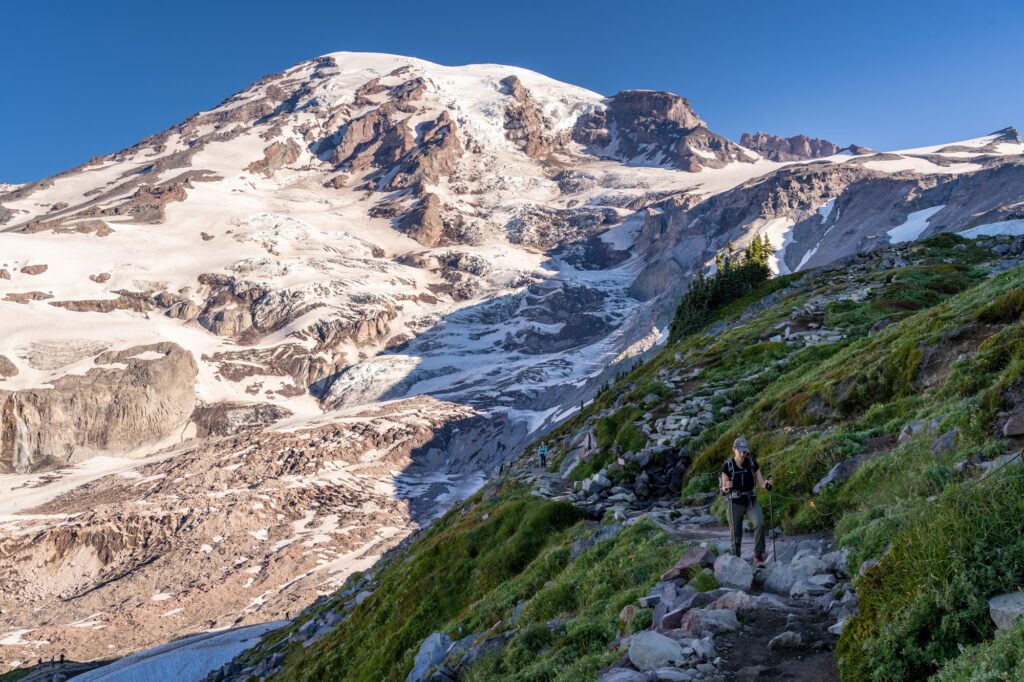
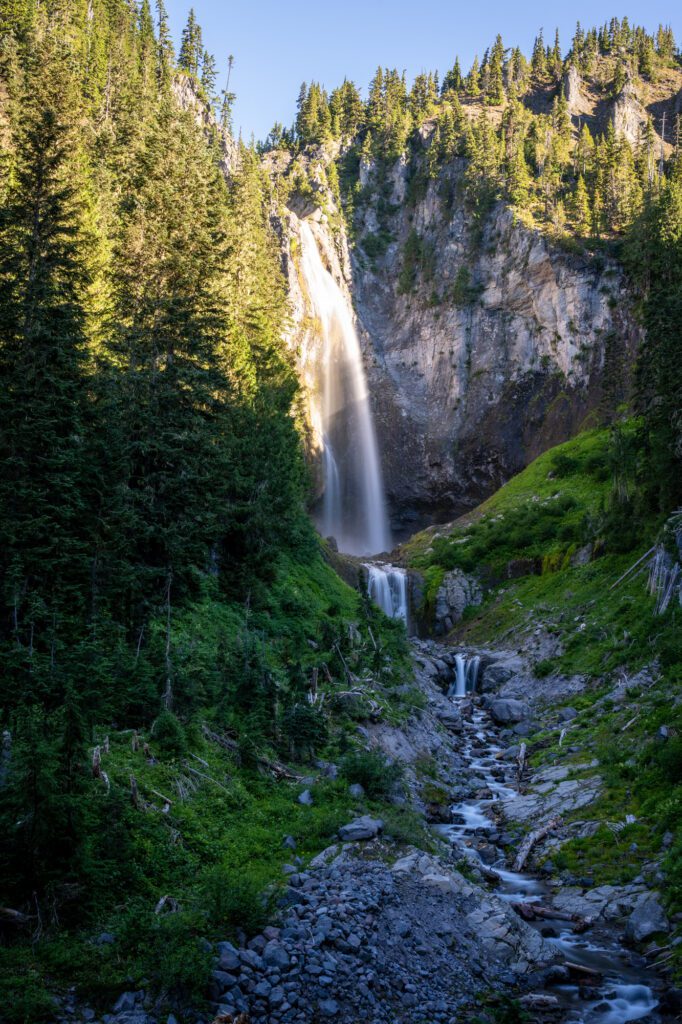
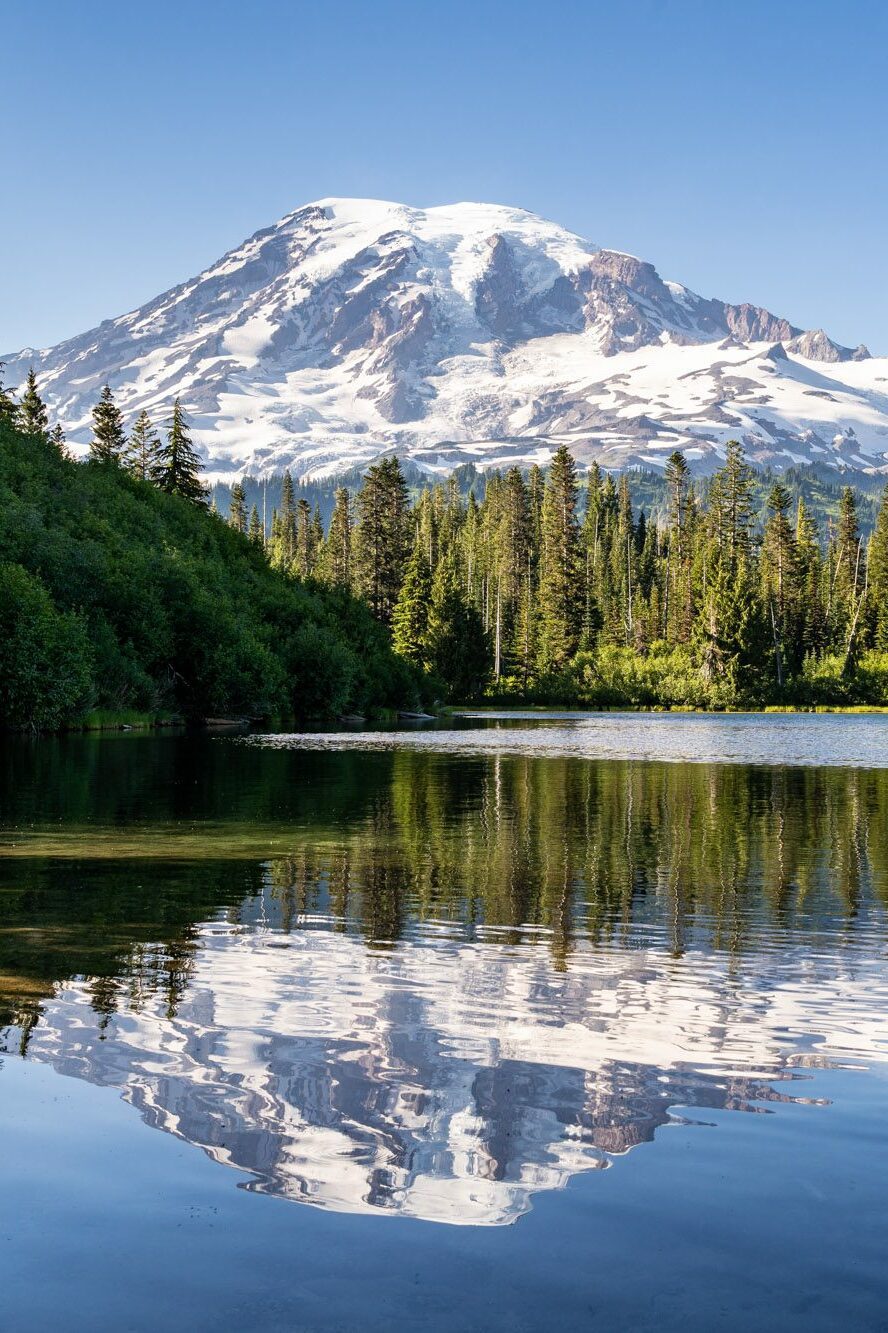
Take Advantage of the Excellent Hiking Around Sunrise
At Sunrise, it’s all about the hiking.
There are three excellent hikes that leave from the parking lot of the visitor center, head along picturesque Sourdough Ridge, and offer very different experiences along the way.
Burroughs Mountain: Get so close to Rainier’s peak you can almost reach out and touch it. There are three burroughs, and the official trail goes to the first two. The third burrough adds significant distance and elevation gain, but is worth the effort if you have the fitness level and appetite. The hike takes you up from the lush subalpine meadows into the high alpine tundra, which is largely barren and rocky, which is a fun contrast. Read our trail guide here.
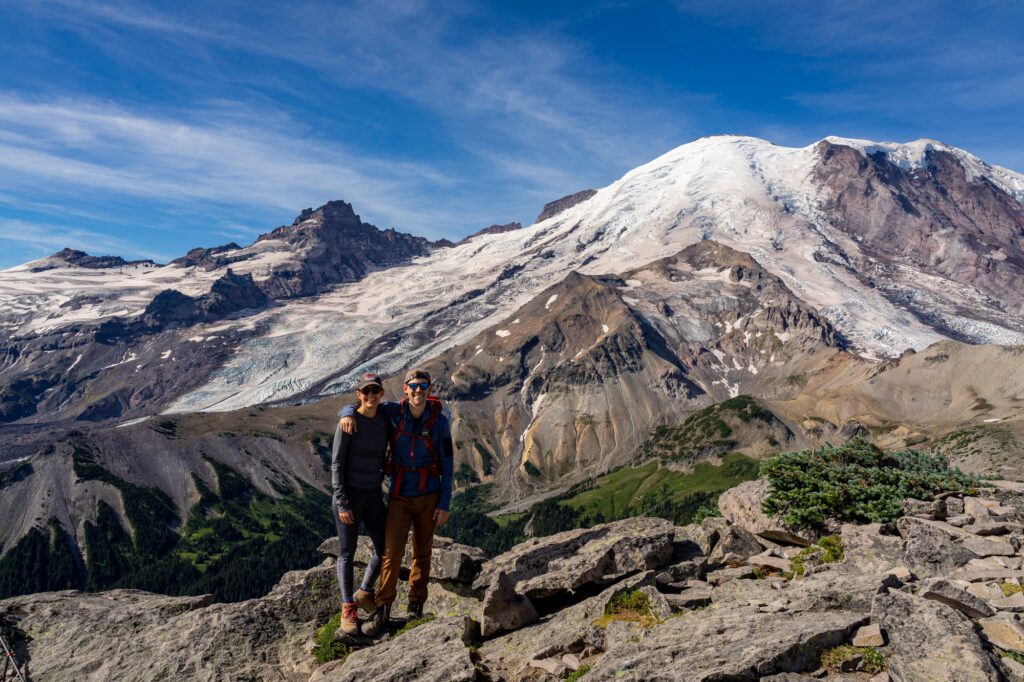
Mount Fremont Lookout: A hike to an old fire lookout – there are a bunch of them in Washington State – with excellent views out over the valley towards Rainier. Keep an eye out for marmots along the ridge as you approach the lookout. This is a VERY popular sunset spot, so be prepared for crowds.
Berkeley Park: THE place to go for a week or two in the summer (usually late July or early August, but depends on the year) for the wildflower meadows. It’s a sea of lupine, paintbrush, and all sorts of white and yellow flowers.
A special shout out for Tipsoo Lake and the Naches Peak Loop at the base of the road up to Sunrise, which is probably the best bang-for-your-buck easy hike in Washington State.
And also for the Summerland Trail to Panhandle Gap, which is also worth your time (though it’s a tougher hike).
Olympic National Park
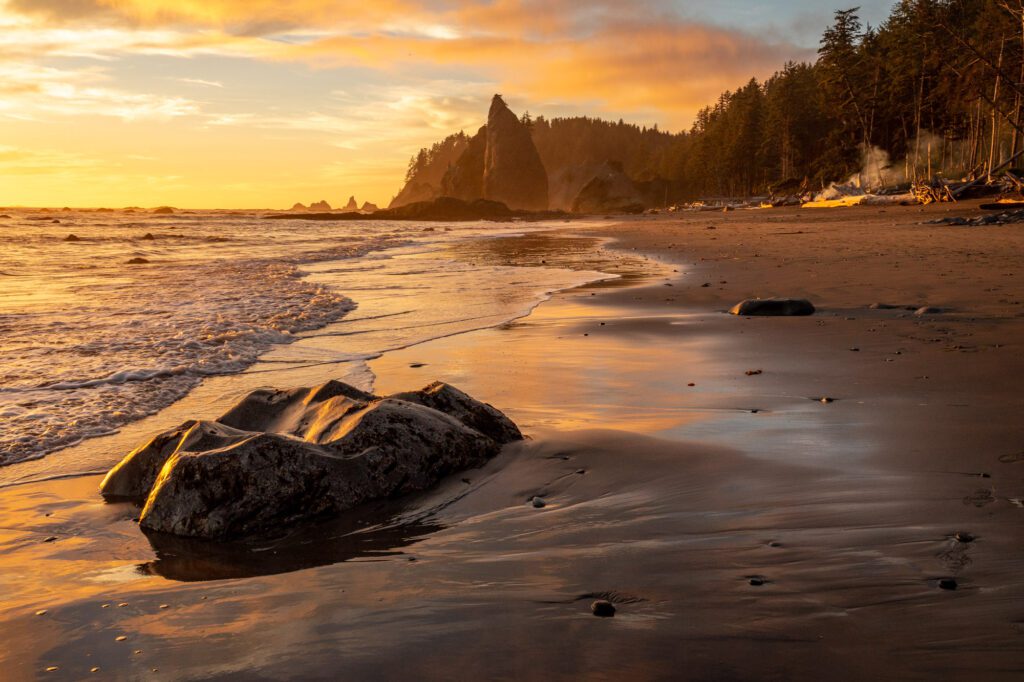
Olympic National Park is, perhaps, the most diverse national park on the west coast (maybe the country?) in terms of the number of different ecosystems that exist within its sprawling borders.
The three main ecosystems you’ll come across are the rocky coastline, the coastal temperate rainforest, and the rocky alpine region, and each offers a unique set of sights, smells, and sounds.
The reason all of that diversity can exist within the boundaries of the park is that the park boundaries are sort of drawn like a voting district. And by that, we mean they make almost no sense at all from a geographical standpoint.
As you’re driving Highway 101, you’ll weave in and out of the park boundaries without even knowing it.
The reason we bring this up is that it has a practical implication for your trip. To get between the two main regions of the park – the coast and the alpine area at Hurricane Ridge – it will take you at least an hour and a half, usually more.
For that reason, we would STRONGLY recommend making this a long weekend trip (3 days / 2 nights, at a minimum) and splitting your nights between two areas to minimize the amount of time you spend driving back and forth (more on what those areas should be and what direction to go in the subsections below).
We love Olympic National Park, and there’s something really special about hiking at 7,000 feet above sea level in the morning, and then ending your evening on the Pacific beaches at sea level watching the sunset over the sea stocks and driftwood.
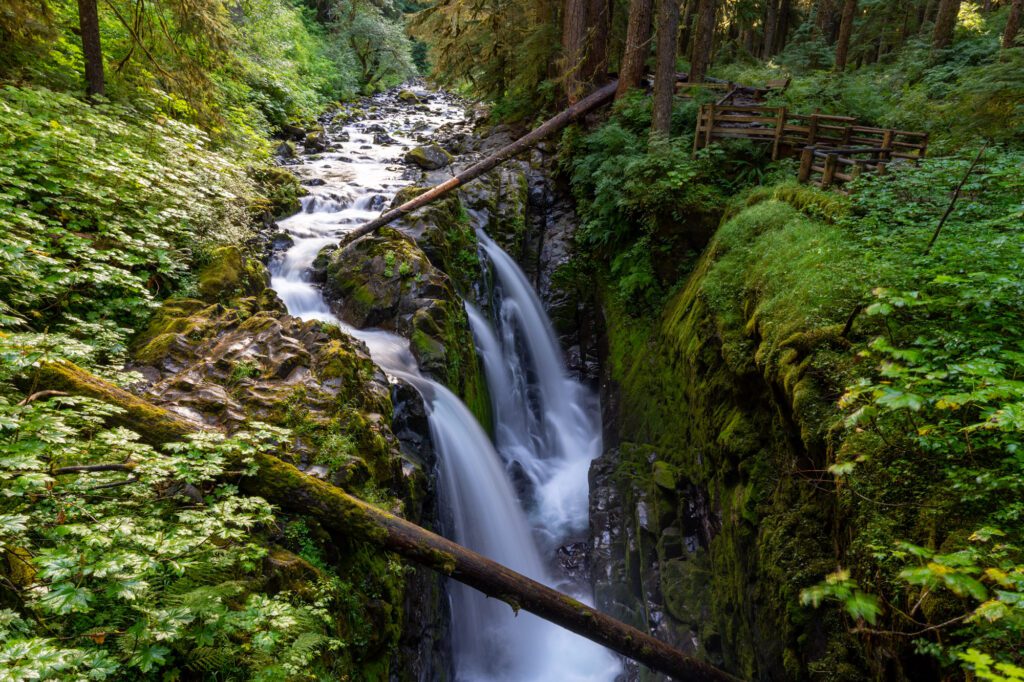
Olympic National Park is on the Olympic Peninsula, across the Puget Sound from the city of Seattle in the northwest corner of the contiguous United States.
The park is fairly sprawling, and when you look at it on a map and consider drive times, it’s massive.
There are two starting points (or main hubs) for visiting the park, and they are the cities of Port Angeles and Forks.
We’d recommend making your weekend getaway a loop that starts in Portland, heads up to Port Angeles, and loops down the coast on your way back to Portland.
Port Angeles is further from Portland, which means you’ll hit the longer leg of the drive on the front end, when you’re bright eyed and bushy tailed, and then have a slightly shorter drive home on the back end.
What to Do in Olympic National Park
As mentioned above, Olympic National Park is massive, which means we’re going to organize this section by region.
The four regions we’re going to focus on are Hurricane Ridge, the Sol Duc Valley, the Pacific Coast, and the coastal temperate rainforest.
Which, conveniently, are in the order you’ll encounter them if you start at the northern end of the park near Port Angeles and make your way south along Highway 101 to Kalaloch at the southern end of the park.
P.S. Once again, we have plenty of detailed guides behind this summary to help you plan your trip out to Olympic National Park. We have a guide to planning a perfect Olympic National Park Itinerary, a guide to our favorite things to do in Olympic National Park, a guide to hiking in Olympic National Park, and a guide for choosing where to stay in Olympic National Park. Read those for more information to help you plan your trip!
Experience Hurricane Ridge
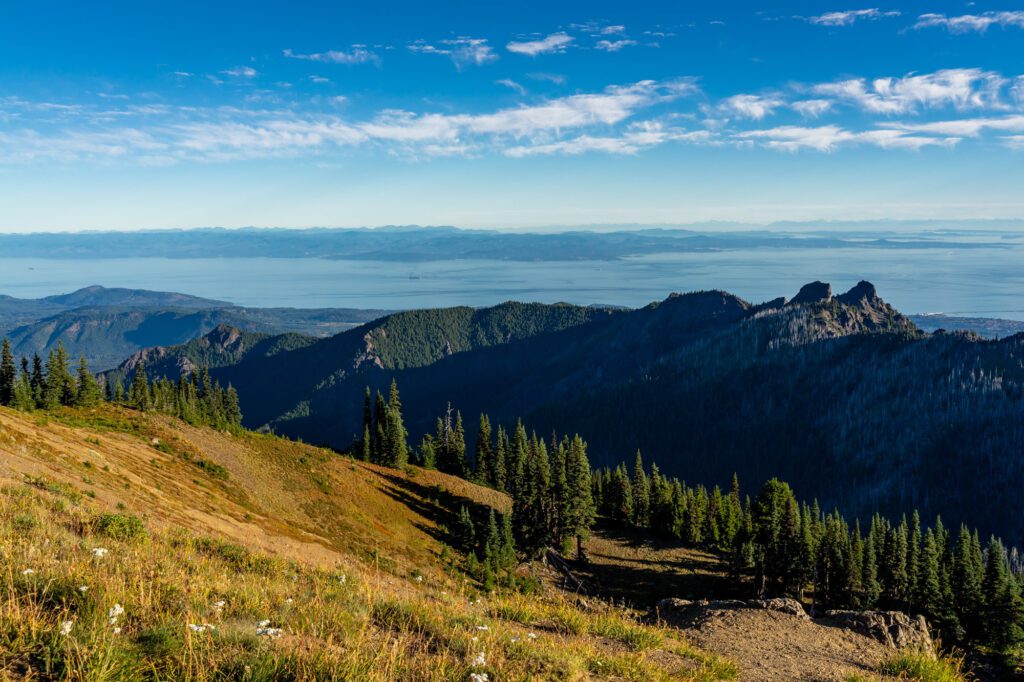
Hurricane Ridge is the highest point in the park that you can drive to, and as you climb the steep, winding road from sea level, you’ll start to see the landscape subtly shift.
When you emerge onto the ridge, you’ll be face to face with the Olympics looming across the Hoh River Valley directly in front of you.
The first thing to do is the hike to Hurricane Hill, which gives you a panoramic view out over northern Washington and southern British Columbia.
If you’re looking for a longer hike, you can head to Klahhane Ridge, which has a few different options depending on how much hiking you’re up for.
The second thing you should do here (provided it’s the summer) is drive out along Obstruction Point Road, which is a narrow gravel road along a ridge only accessible to passenger vehicles (no RVs or trailers).
There are some great views along the way, and some good hikes from the parking area at the end.
The Sol Duc Valley / Lake Crescent
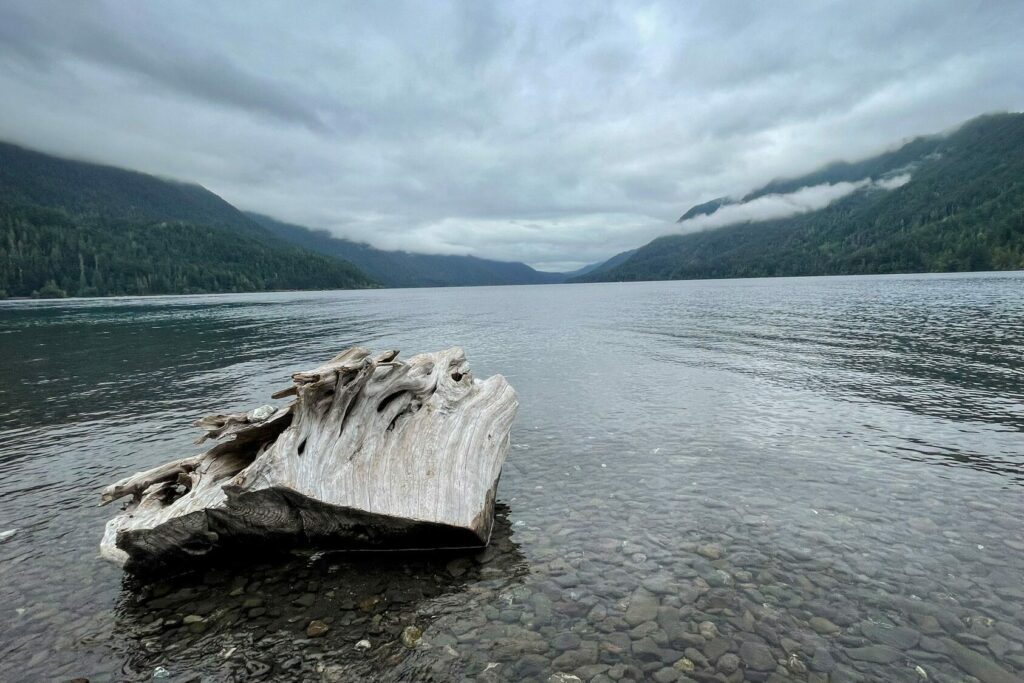
The Sol Duc Valley sits roughly at sea level just west of the road up to Hurricane Ridge, and is a vastly different landscape.
Here, it’s all about lush evergreen forests and Lake Crescent, which is very much the star of the show.
At Lake Crescent, we’d definitely hike up to Marymere Falls, which is a short, easy jaunt. If you’re looking for a bigger hike, head all the way to the summit of Mount Storm King, which is harder (and involves some rope-assisted climbing at the end).
Afterwards, head over to the historic Lake Crescent Lodge, which is right on the shore of the lake, for a drink and a picnic lunch.
Don’t miss the drive up Sol Duc Road to Sol Duc Falls, one of our favorite waterfalls in the park.
The Beaches on the Pacific Coast
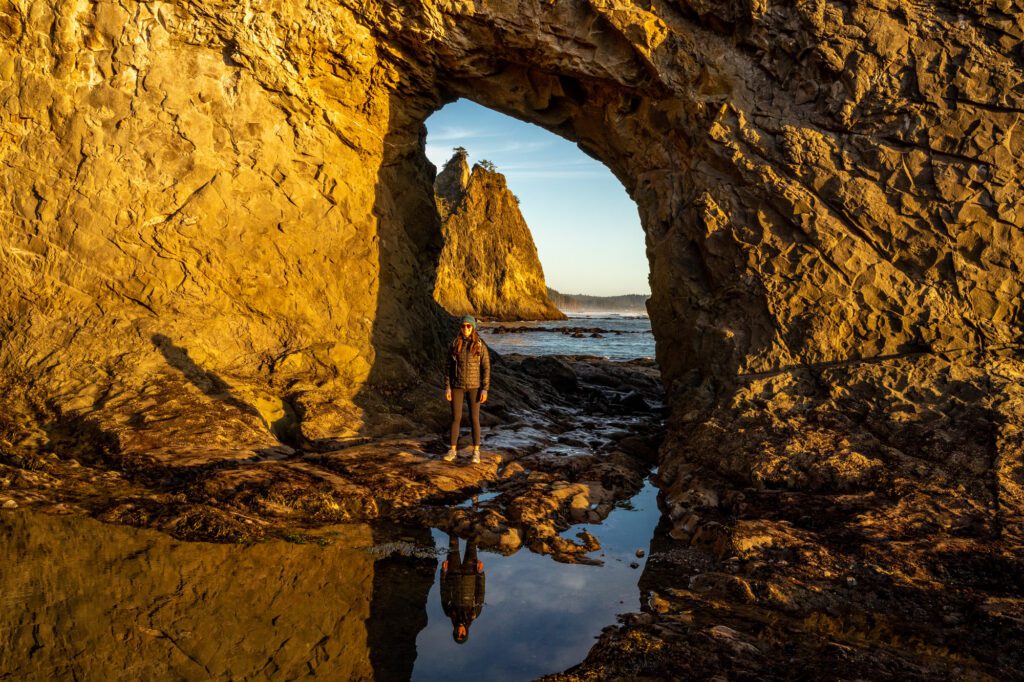
The Pacific Coast is about an hour west of Lake Crescent, and the main city nearby is Forks, which you’ll know of if you grew up in the early 2000’s because it was ground zero for the Twilight saga.
There are two subregions here – the northern Pacific Coast and the southern Pacific Coast – and with limited time (e.g. two or three nights), we’d strongly recommend focusing your time on the southern portion, which is more accessible and offers more bang-for-your-buck.
Don’t miss Ruby Beach and Second Beach, two of the best driftwood-laden, sea stack-y beaches on this stretch of coast.
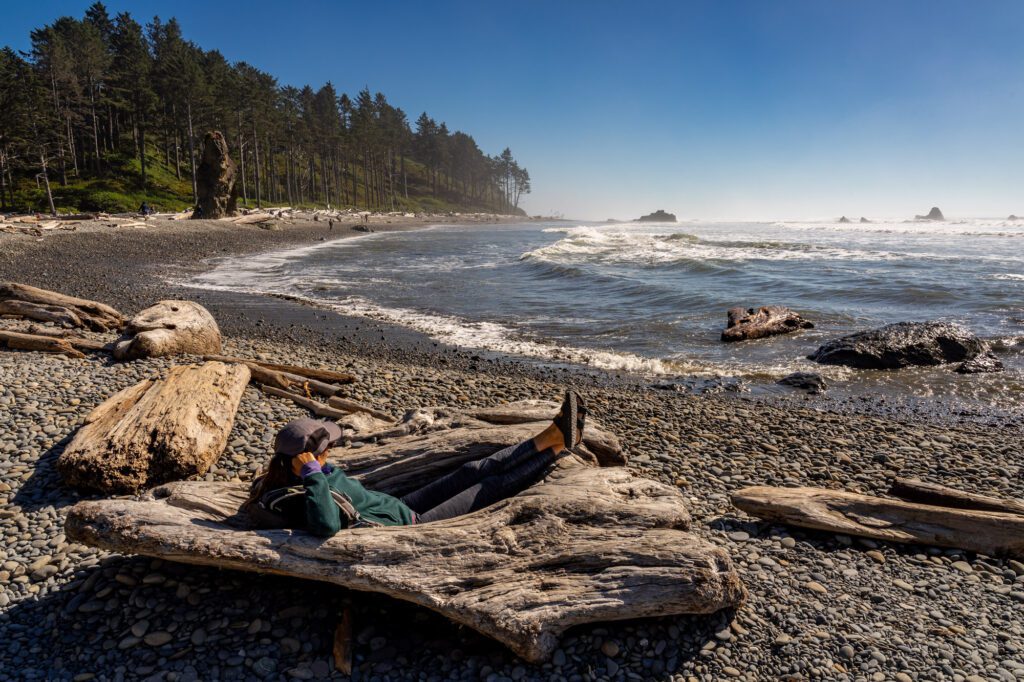
We’d definitely try to do the easy hike on Rialto Beach to Hole-in-the-Wall around sunset if the weather is holding up, which is one of our favorites.
Don’t forget to look up for bald eagles in the treetops on the beach!
The Coastal Temperate Rainforest
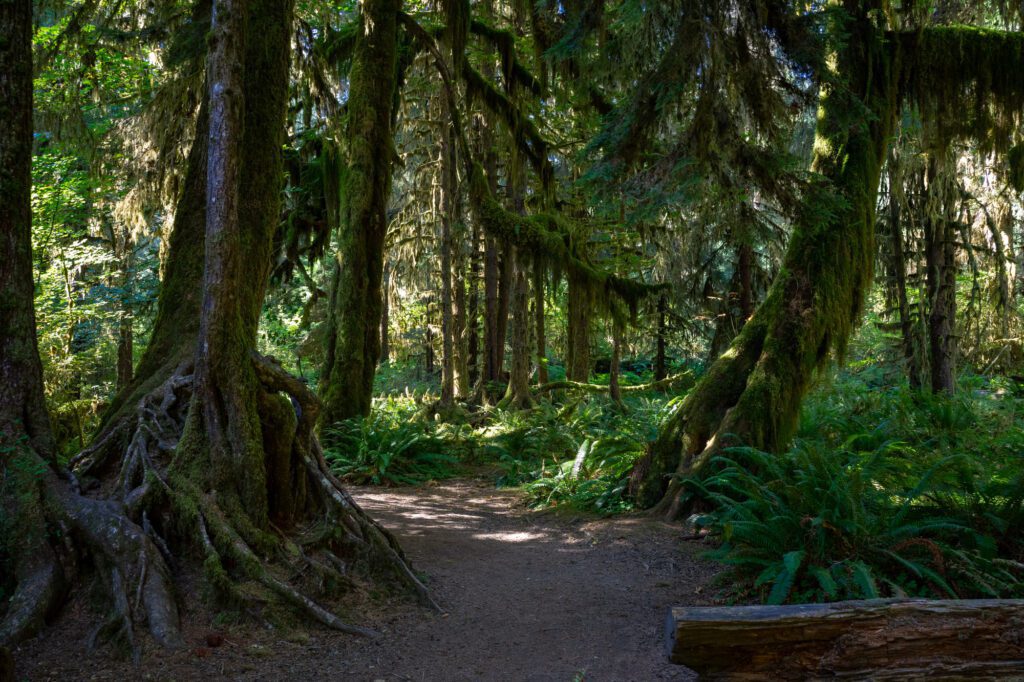
Perhaps the most unique ecosystem out here is the coastal temperate rainforest, which thrives in the mild, wet climates of the Pacific Northwest coast.
The Hoh Rainforest is the most famous example in the park, and it’s no surprise that it’s also the most busy. Parking is very limited, so our best tip is to show up before 9am (if you’re there either on a weekend, or any day in the summer) to avoid having to wait in the one in, one out line at the entrance station.
Plus, that’s the best time to see the resident Roosevelt elk that hang out in the rainforest!
Once you’ve navigated the parking situation, hike the short Spruce Nature Trail and Hall of Mosses, which are about two miles together. If you’re looking to get deeper into the rainforest to find a bit of solitude and escape the crowds, we really like the Hoh River Trail.
It goes all the way to Mount Olympus, but the portion you’re focused on here is the first 2-3 miles of trail, which take you through the lush ferny rainforest and out to the river, which is a good turnaround spot.
